Orchha
Finally we had to say farewell to the nice temples of Khajuraho. Next day we boarded the bus going in the direction to Jhansi. Just 18 km before Jhansi we dropped off at an intersection to switch to an auto-rickshaw to finally get to the town of Orchha, which means Hidden Place. That's what it is. Secluded and tranquil, a very nice place to relax and leisurely strolling around but still experiencing something new around every old corner. But it must have been a busier place between the 16th and 18th century, when Orchha was the capital of the Bundelas and now just a small town.
It also has a good selection of budget hotels, of which we inspected several ones at the gate in the middle of town surrounded by market stalls and souvenirs shop, but we chose the quiet
Hotel Ganpati
Main Street
Tel: 91-7680 252765
|
It is owned by a nice family. The rooms are ok and leading to a garden and from there the view from the terrace is superb.
Click the small picture to get it large
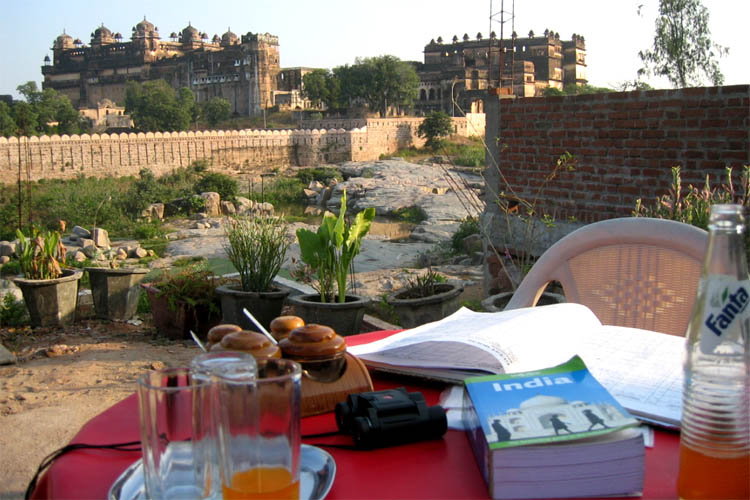
| Having breakfast on the hotel's terrace
|
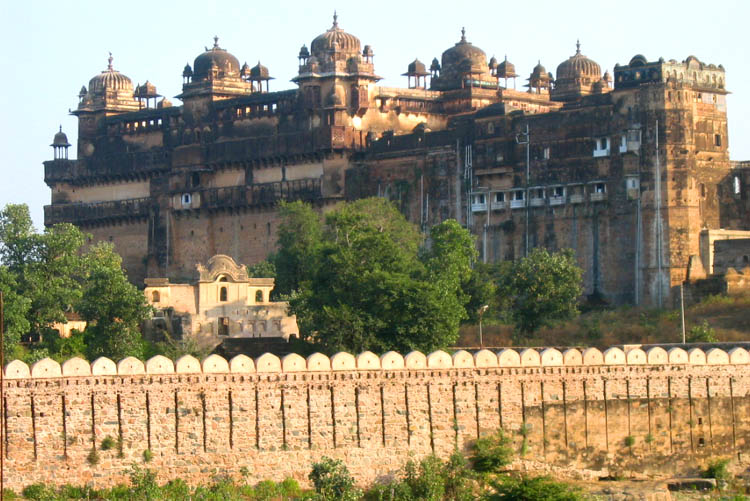
| while enjoying the view to the Orchha palace
|
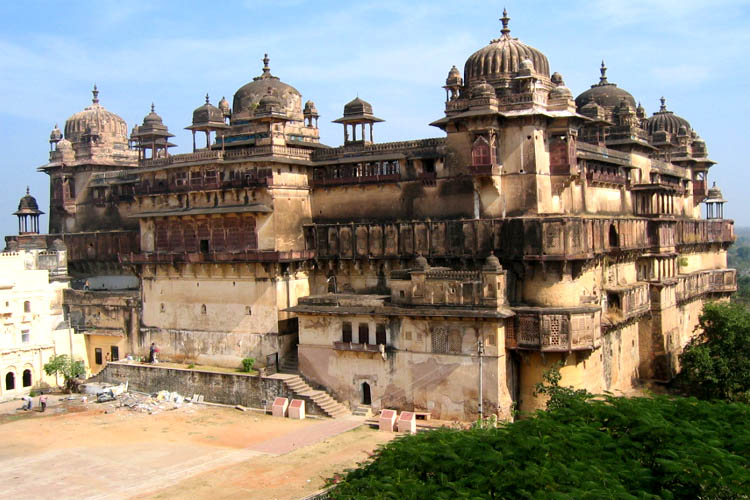
| An even better close up look from inside
|
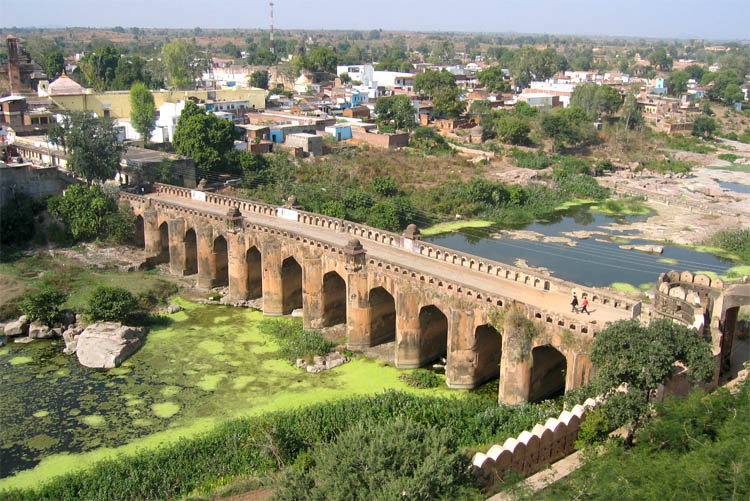
| but where was our breakfast table? On the far right?
|
It really is a picture book setting. How must it have looked during the Golden Age in the 17th century. The palace Jehangir Mahir is on an island embedded in the Betwa river. You have to cross the bridge to get in, after you have paid a small entrance fee.
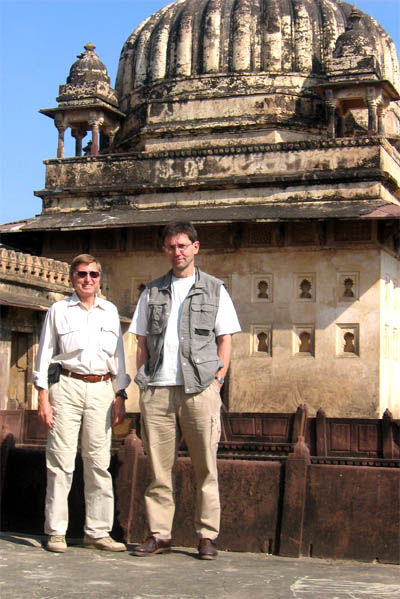
| Manfred and I, on guard
|
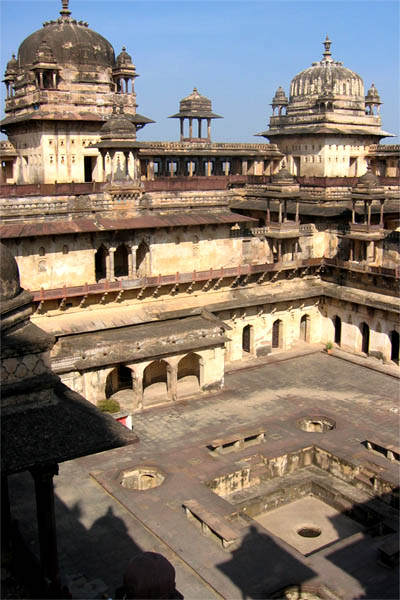
| on the palace tour we start
|
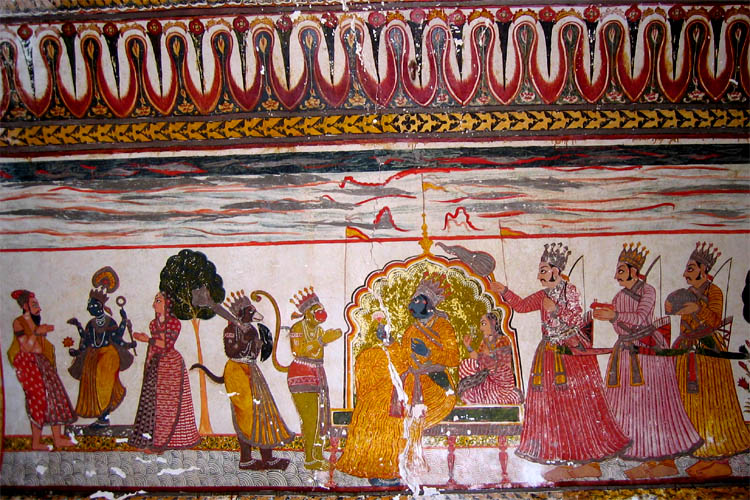
| Painting with the three wise kings from the Orient?
|
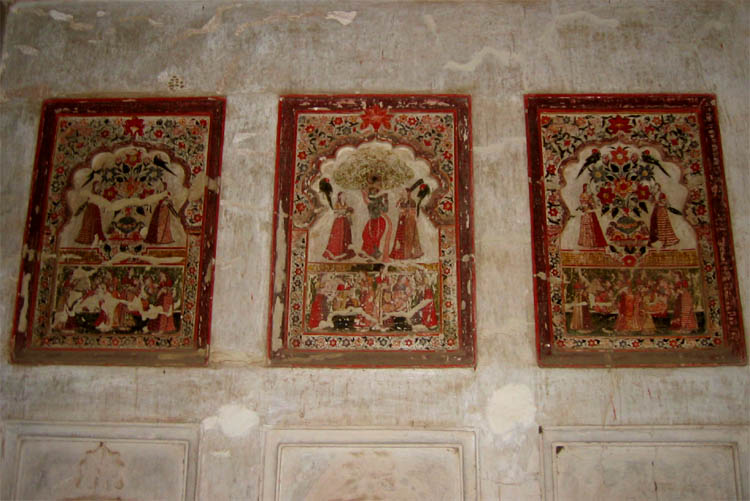
| Three paintings on a wall with many ornaments
|
It's a pity that not much renovation has been done. Even the palace hotel, which is also housed within the walls, is only a remnant of past splendor. Watch your step and look up to the roofs while walking around in some parts of the palace because some walls and roofs don't look that robust anymore. Temples are better maintained, like the impressive Ram Raja temple on the other side of the river (seen through the window frame below).
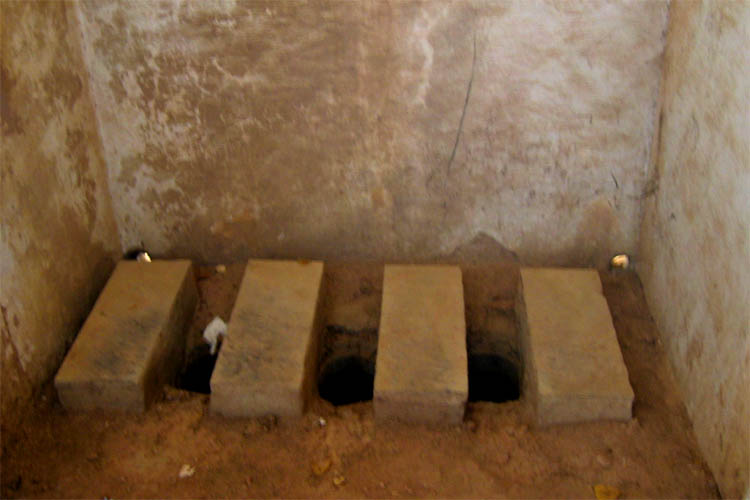
| Here you aim your shit outside through the hole down right
|
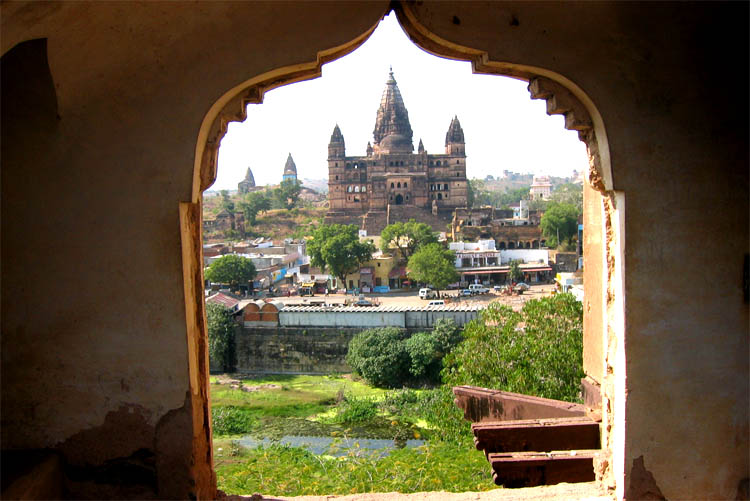
| and then looking out the window and admire the sight
|
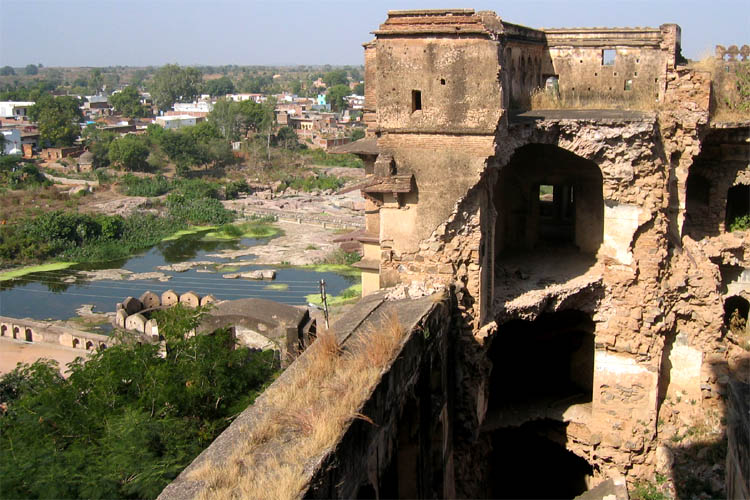
| Does not look safe and not very stable
|
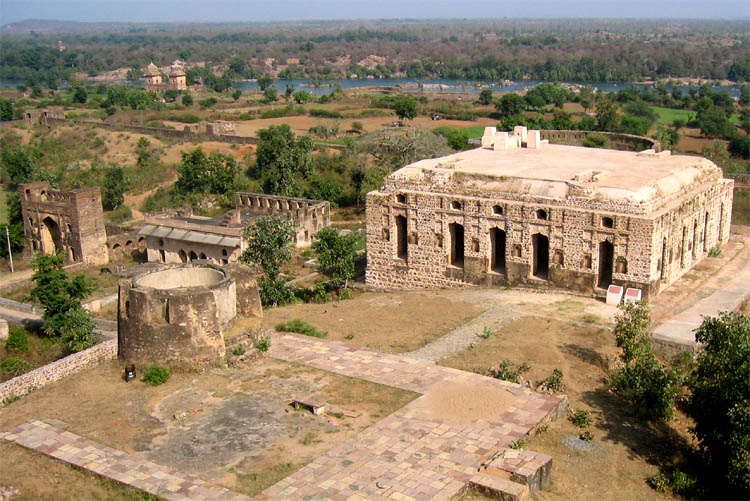
| better get down to the camel stable
|
After visiting the palace we wandered around and down south along the river where we passed small villages and a temple here and there. No women were working in the fields but building streets. One was leading to the best hotel in town: the Orchha Resort, where men were working as waiters, no waitresses were around.
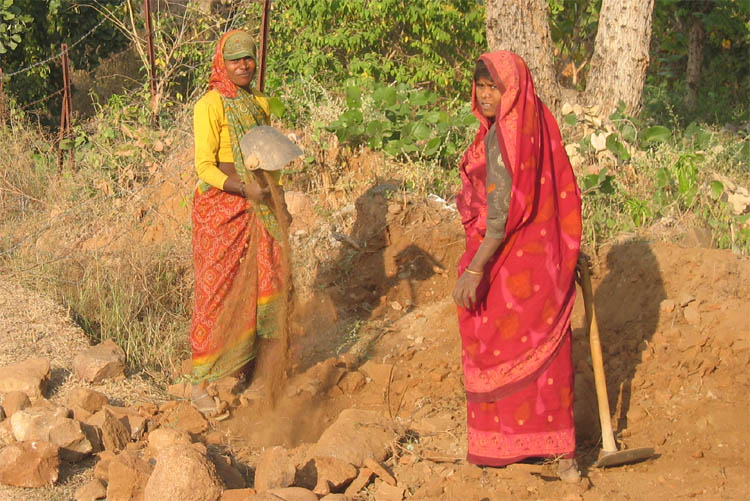
| Indian female street workers have no rights
|
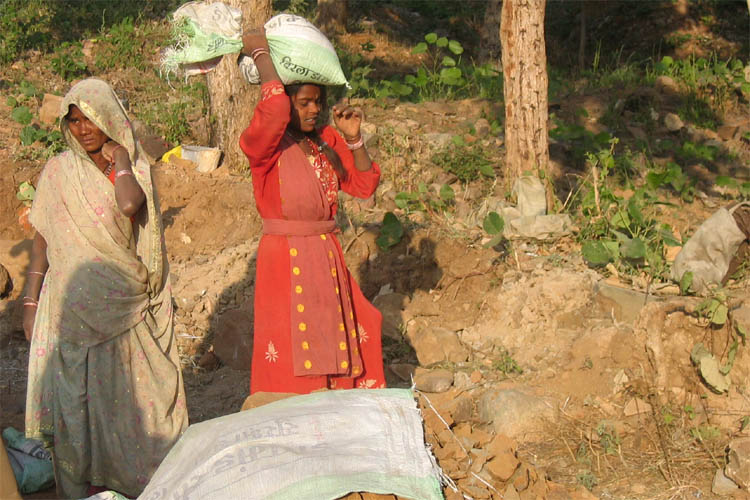
| Solidarity European feminists, ready for fights?
|
No rest under shady palm trees with a drink in hand but more stress to visit the burial buildings, or better the chatris, as the cenotaphs are called, build in remembrance of the former rulers, not necessarily the real burial ground.
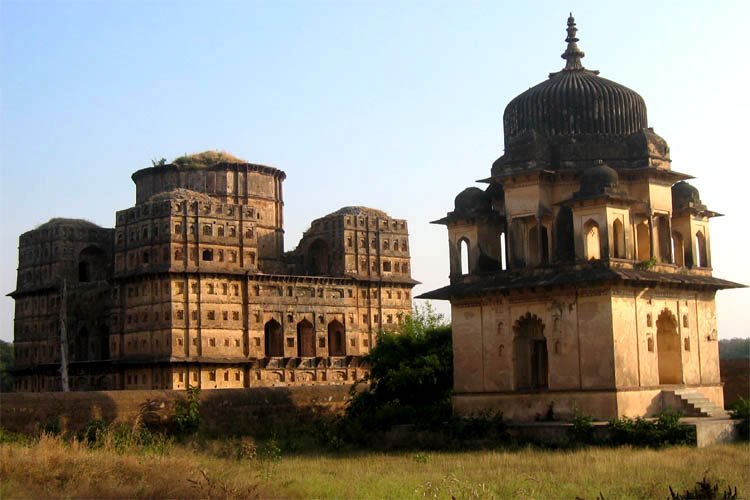
| One Chattri
|
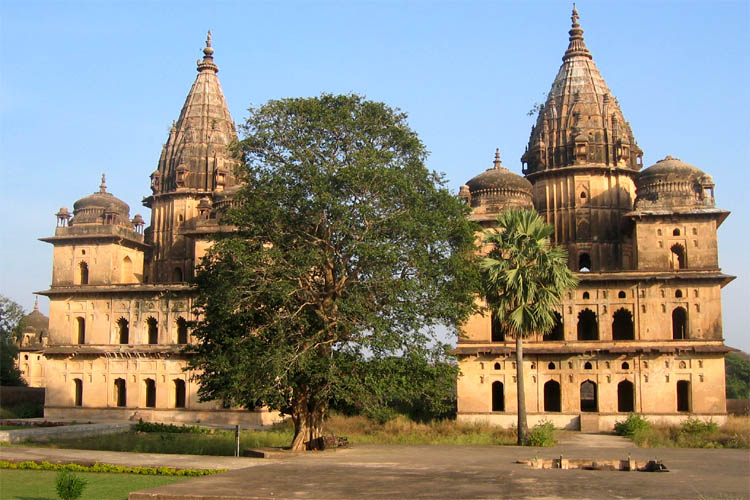
| Another Chattri
|
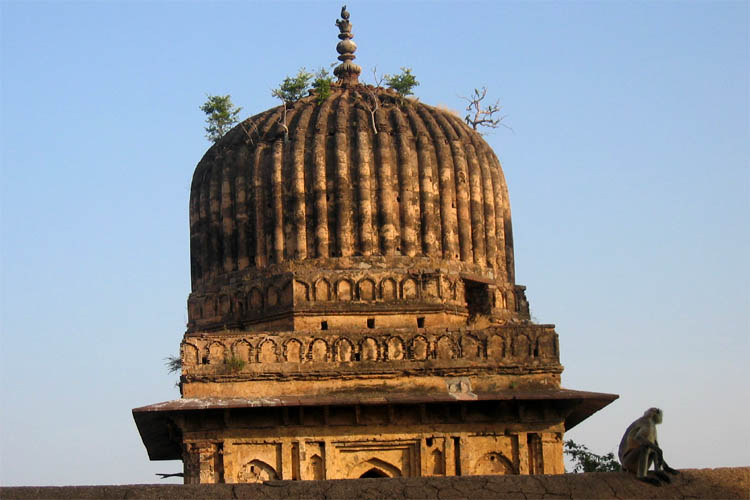
| A monkey on the wall, relaxing
|
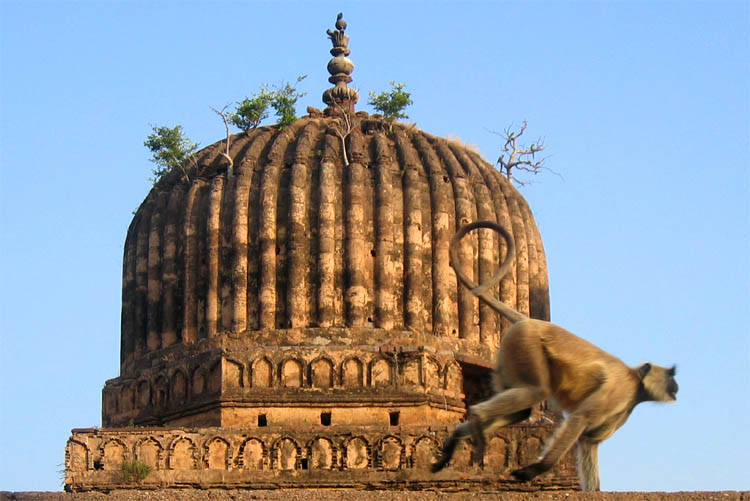
| as we approach, he is escaping
|
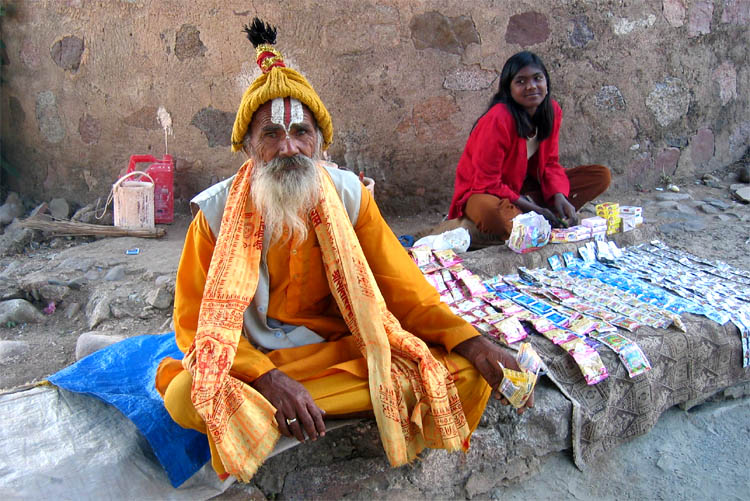
| Better get hold of the old monk
|
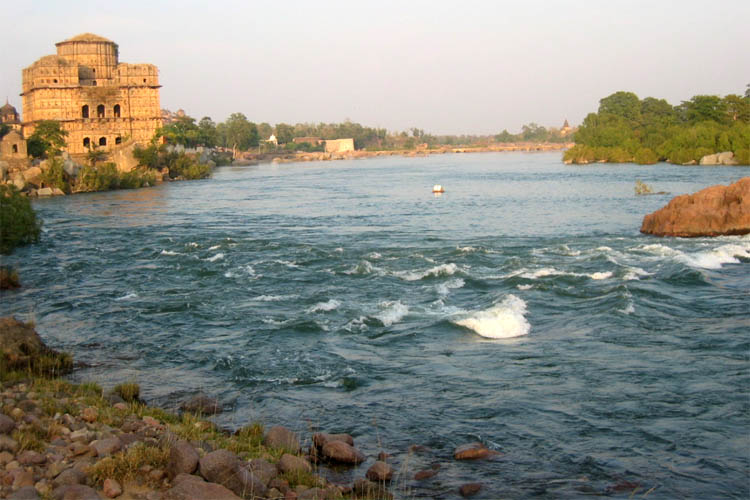
| then further along the riverbank
|
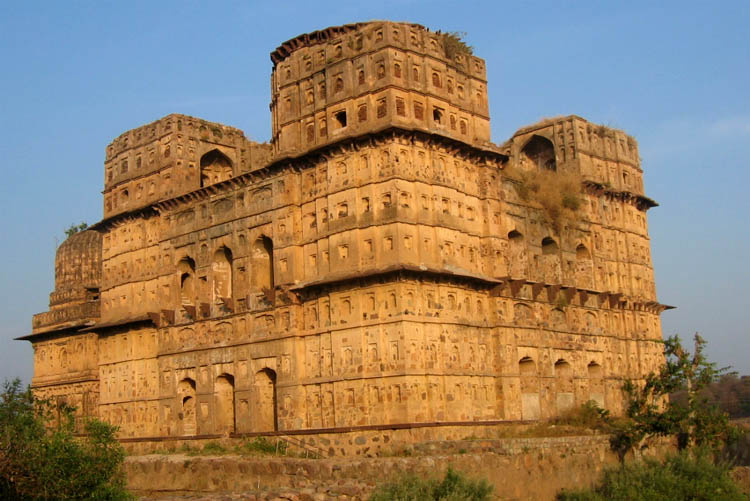
| Let's get a closer look at that building block
|
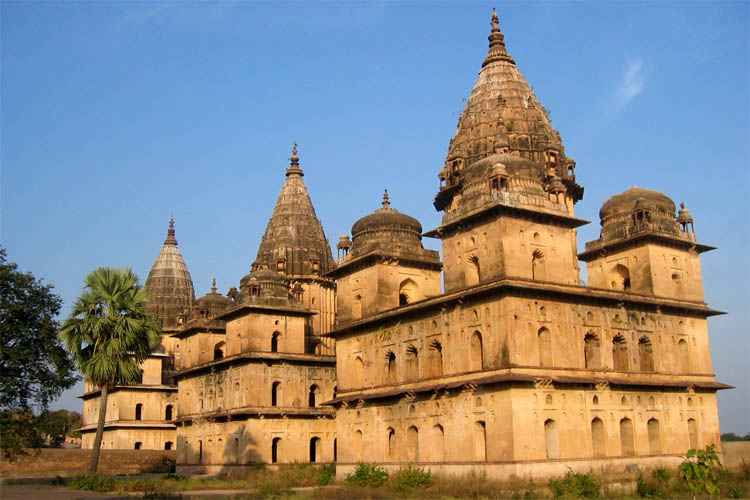
| what is missing on a tower is a tower clock
|
We weren't thinking of eating during our sight-seeing tour, but now, as we passed the all vegetarian Ram Raja Restaurant (on the road between town and palace), we could not resist. For only 20 rupees (35 cents) for the thali (or meal), all you can eat.
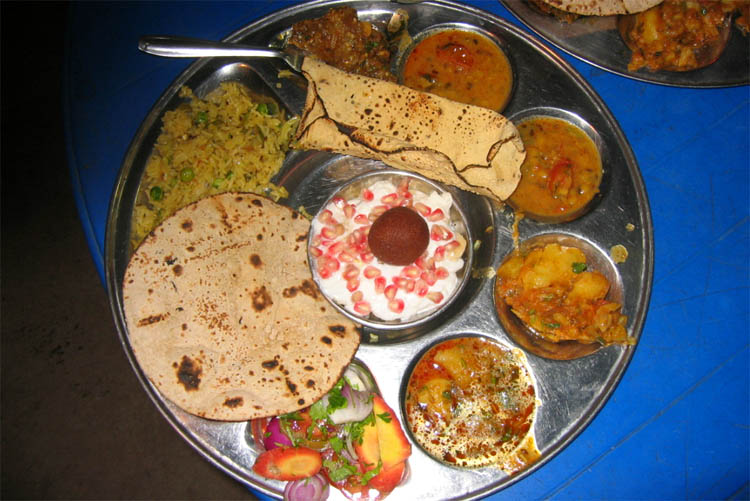
| This meal really makes you full
|
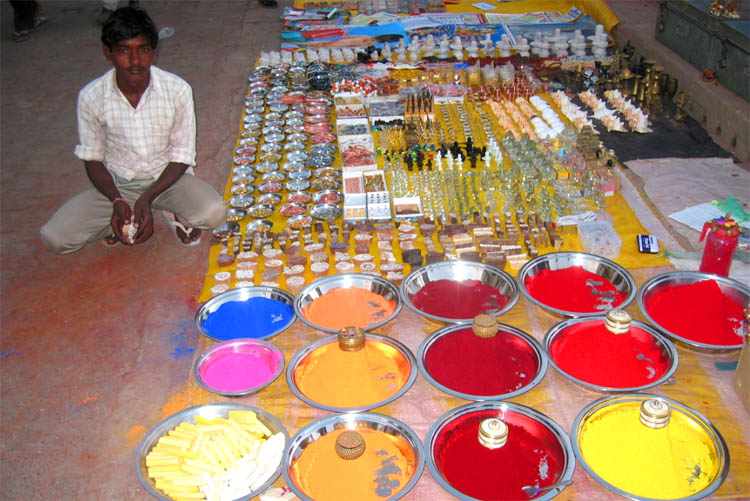
| but this looks more colorful
|
Now my final action but passively: having a massage by a German lady, which owns the "Maya Shop for Body Mind and Soul" located next to the Ganpati Hotel. It seems that she lived in this town already for ages. She also sells all kinds of handicrafts and esoteric stuff beside providing all kinds of massages, like Reflexology and Reiki, reading Tarot and tailors Indians costumes for you. You name it, she can do it.
Sanchi
Next day back on the road and then on the train again. First we went the 20km (or so) by bus to Jhansi where we hopped on a train to Vidisha (280km) and then by an auto-rickshaw to Sanchi (10km), the other famous Buddha site. The first night we stayed at the
Sri Lanka Mahabodhi Society Government Guesthouse.
Lodging including luxury tax for 539 rupees (10 Euro).
Sanchi is a site with the oldest and most interesting Buddha structure build by Ashoka in the 3rd century BC. As with time Buddhism was gradually absorbed into Hinduism and then forgotten. British Army discovered the site in 1818 and was somewhat restored between 1912 and 1919. The Great Stupa is 16m high with four gateways carved with all scenes of life, lifes of Buddha and Ashoka, the king who propagated Buddhism 300 years after Buddha went into Nirvana.
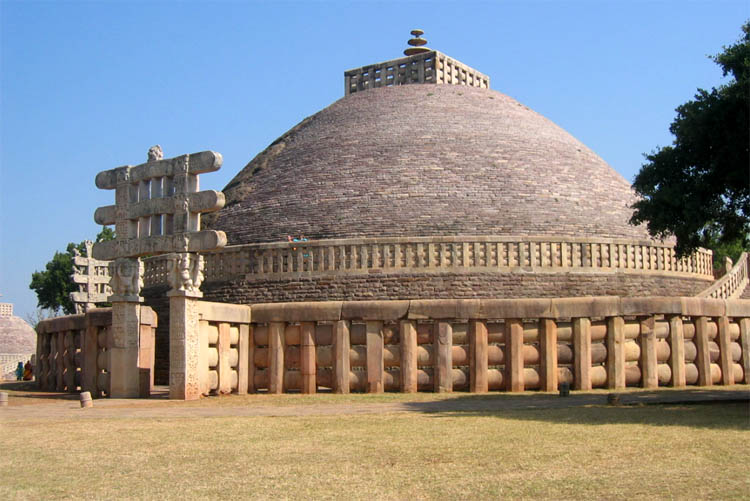
| Sanchi, another famous Buddhist place
|
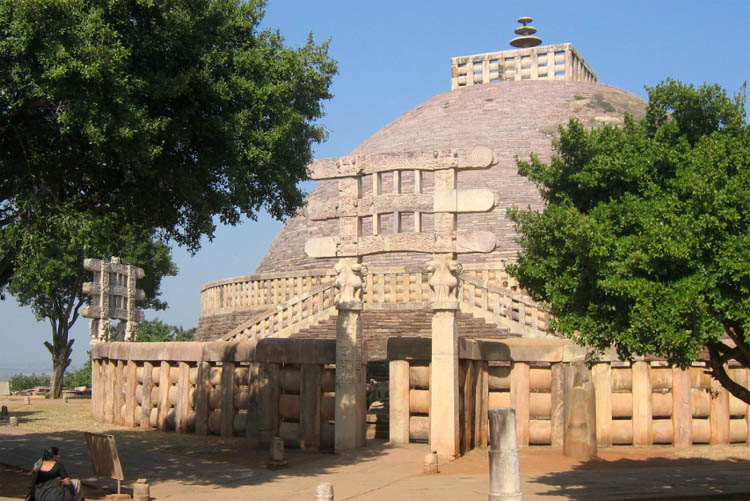
| with the first gate
|
The southern gate, supported by lions, shows events of Ashoka's life and Buddha's birth. The northern gate, supported by elephants, shows for example elephants worshipping Buddha represented by a (Bo) tree. The western gate, supported by pot-bellied dwarfs, shows Buddha in several incarnations. The eastern gate, supported by elephants again, shows scenes of Buddha entering nirvana.
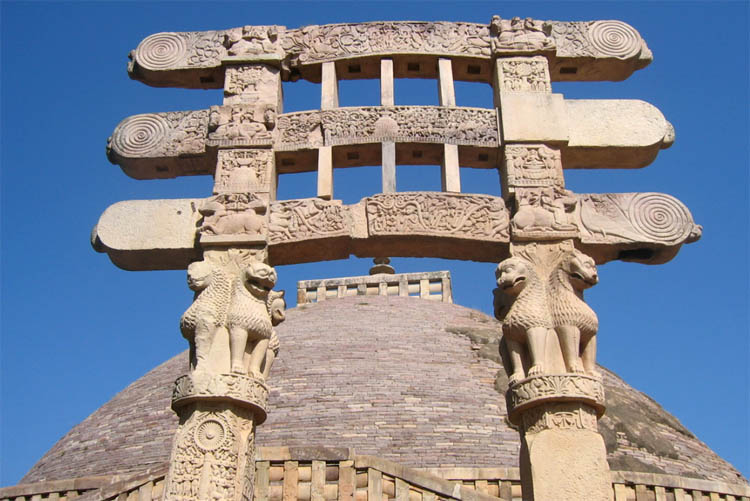
| Southern gate close up
|
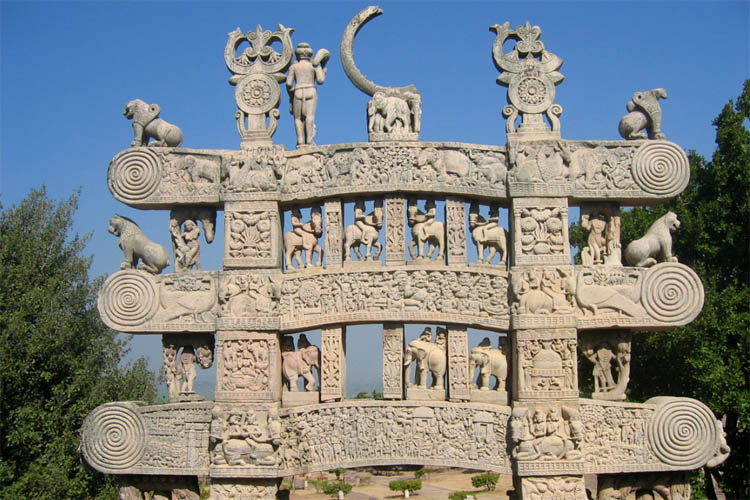
| Northern gate close up
|
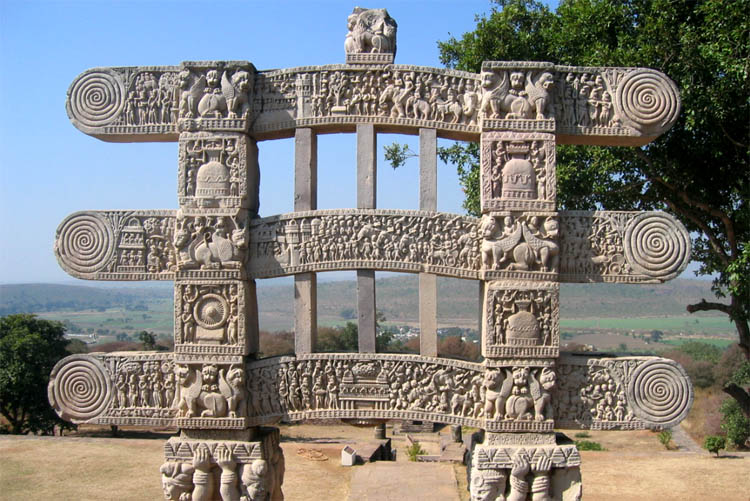
| Western gate close up
|
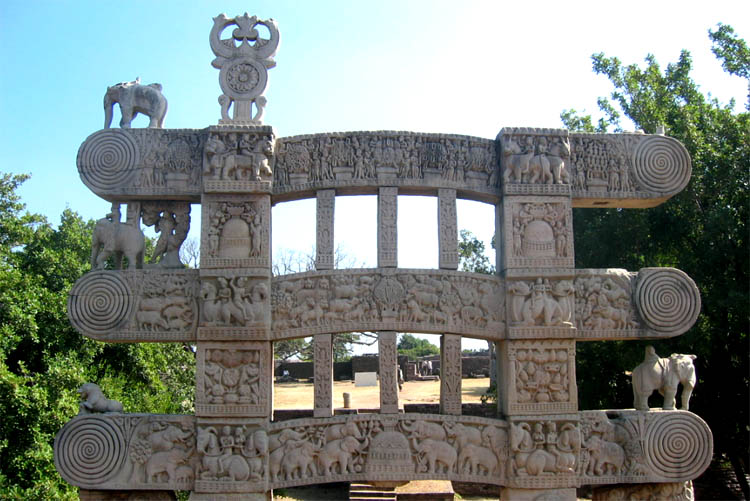
| Eastern gate close up
|
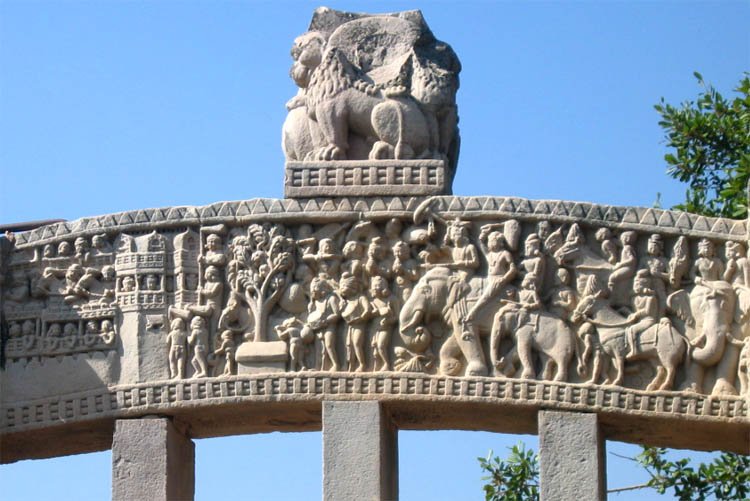
| Procession with elephants and horse
|
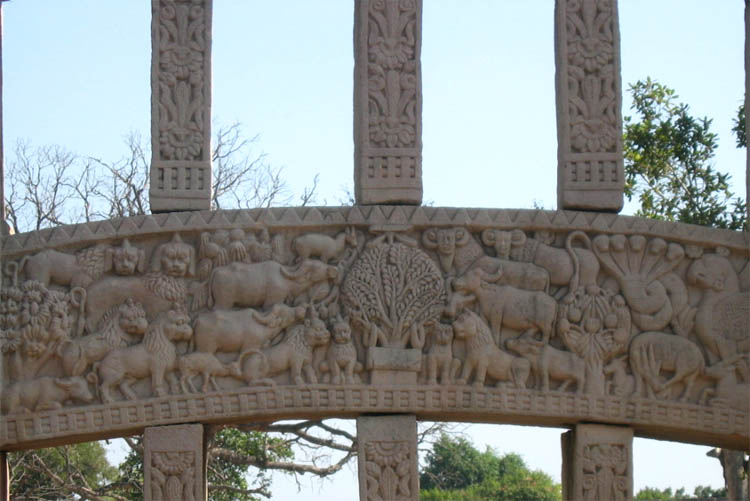
| and wildlife animals coming to the tree
|
Many other stupas and pillars and temples are all scattered around, or what is left of them, with many stories they can tell. Old monasteries made of wood are long gone. Some are of a later period during the transition of Buddhism to Hinduism and you can still see the ground layout of monastery cells.
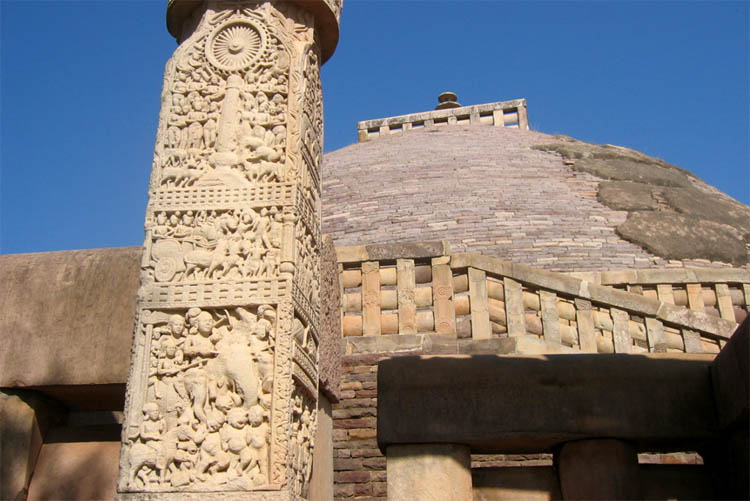
| Must be heavy, this column
|
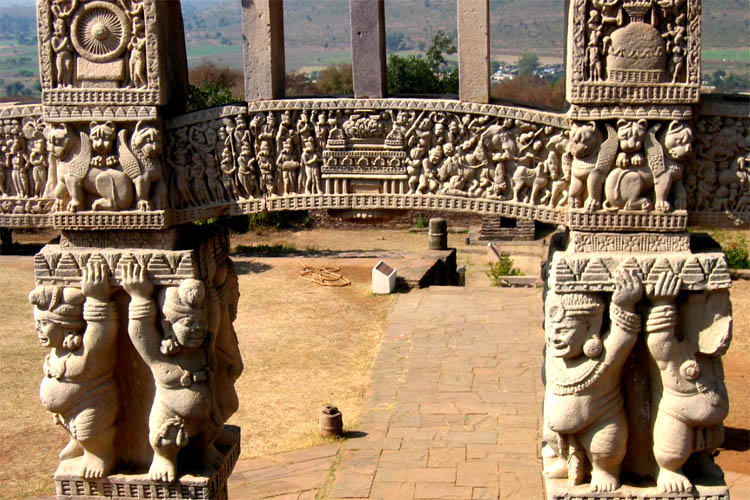
| also to be carried by the dwarfs
|
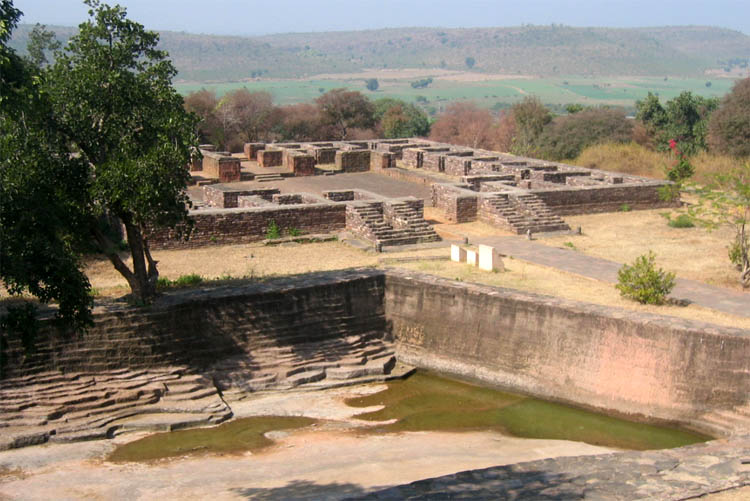
| surrounded by other temples
|
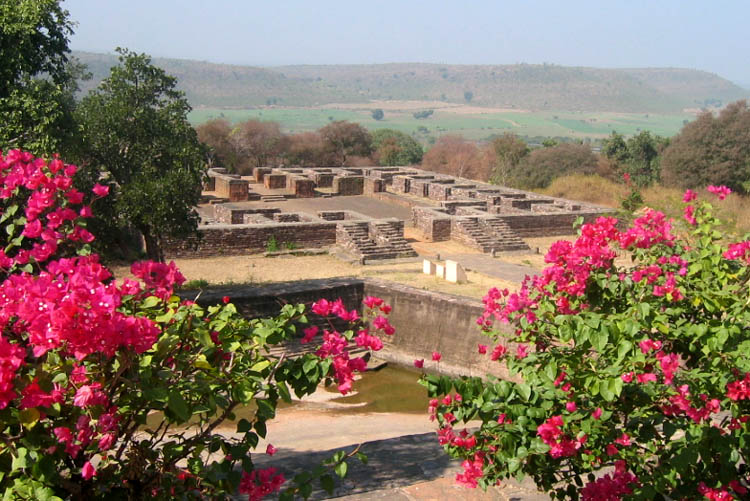
| in a beautiful landscape
|
The second night we were lured into the "newly opened"
Sambodhi International Hotel
on the road to Bhopal 3km from town. It was a wrong decision. Next time we would neither take this one nor the government hotel but a guesthouse right in the middle of the village with some restaurants and shops around (though no need of a television repair).
However this tout praised that "Sambodhi" so much that we thought it a good deal, with a special rate for 200 rupees (3.50 Euro) instead of 1100 rupees (20 Euro) for the room, 1 km from town, swimming pool with garden, restaurant, rooms with hot water, etc. But it was a terrible experience: the swimming pool was dirty and could not be used, no electricity from midnight till the rest of our stay, there was also no running water in the morning, well water had to be heated on an open fire and filled in buckets for our shower, no breakfast available.
And it took time until we were ready to leave that we probably missed our bus out of town. We were waiting at the roadside but no bus came so we hitch-hiked the 46km to Bhopal on a truck.
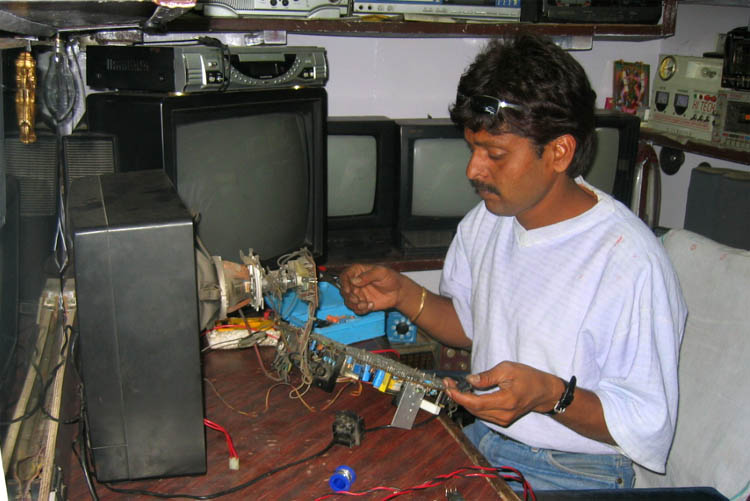
| Will the television work again?
|
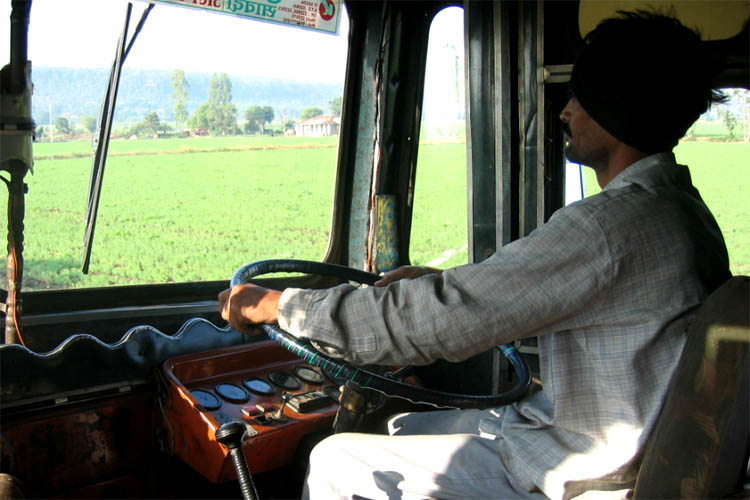
| Thanks for the lift, truck man.
|
The truck driver dropped us somewhere at a construction site where he had to unload his cargo. At first, we did get lost in Bhopal and we wanted to get to the station as fast as possible. Not just being afraid of the leftover deadly gas from the Union Carbide disaster in 1984 but were happy to get a train soon enough to get out.
So on the 6th of December we went by a slow passenger train from Bhopal to Ujjain Junction (184km for 60 rupees), where we had to change train for Indore.
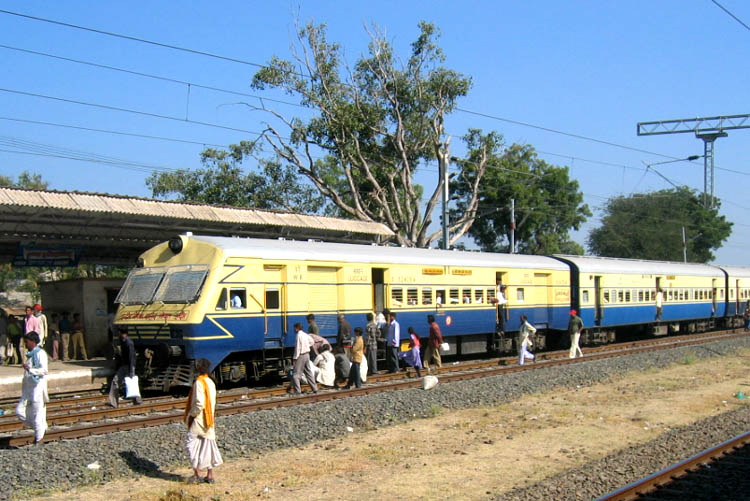
| Riding the Chattanooga train
|
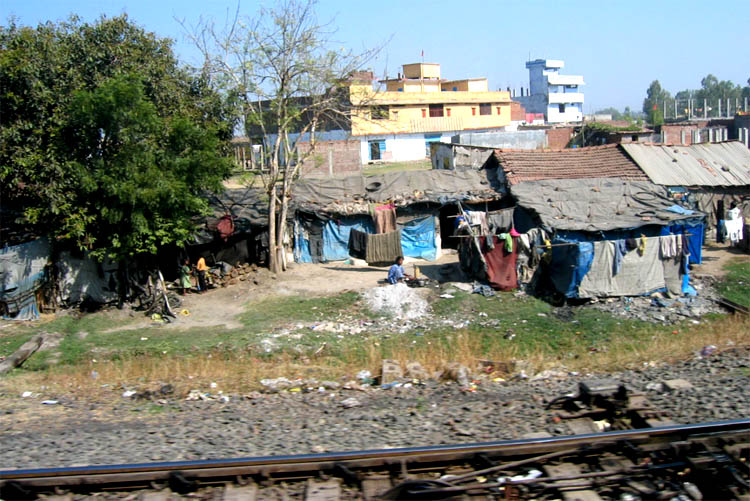
| The shacks outside are not so fine .
|
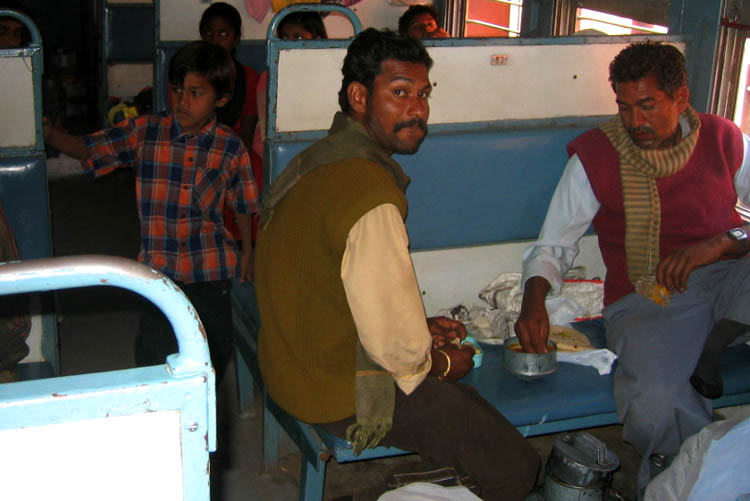
| The seats inside were ok
|
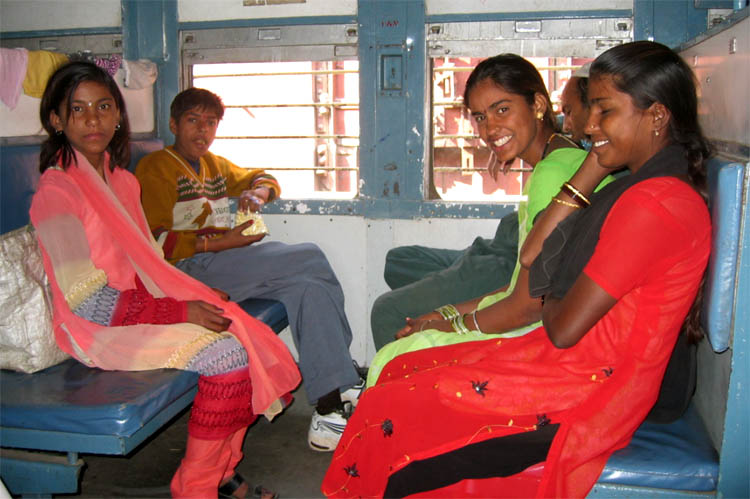
| having next nice company
|
Indore
Indore is one of the few Indian cities were it 's worth to stay a day and night, which we did on our first arrival and when we came back from Mandu, actually our next destination and the reason to come here in the first place. As soon as we arrived at the railway station we looked for a hotel and found the
Hotel Ashoka
14, Nasia Road
Tel:2465991
|
opposite the Sarwate Bus Stand. The room was ok for a rate of 200 rupees (3.50 Euro).
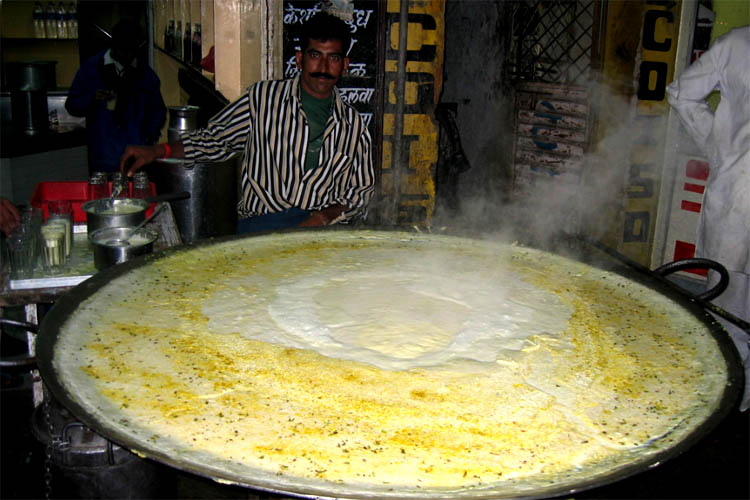
| First thing a couple of sweet milk drinks
|
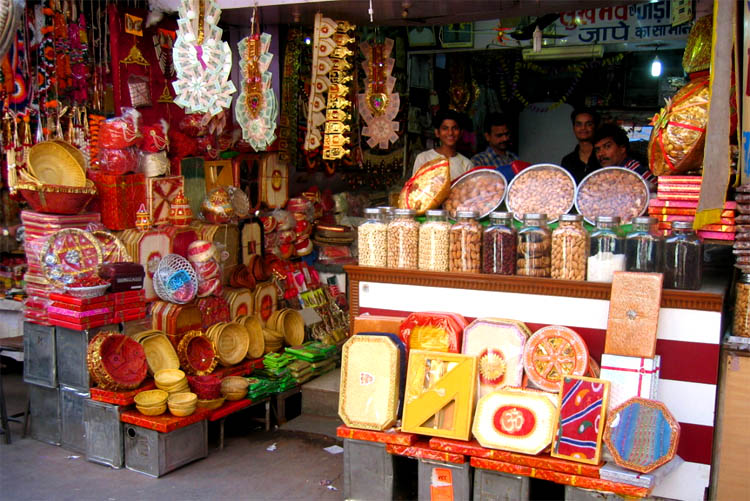
| was real good and better than sweet things
|
We are ready next day for our bus ride to Mandu, which took us the first 2 hours to Dhar and from there with another bus another 1.5 hours.
Mandu
This is another forsaken place like Orchha, more or less set-back but within a larger area. First we had to look for a hotel. Unfortunately the current "top" hotel in Mandu, the
Hotel Rupmati,
was full (with a nice view from the terrace). The room rate would have been around 900 Rupees (16 Euro).
Then the next lower "luxury" class was the
Maharaja Hotel,
with really lowest class budget rooms for 125 rupees (2.20 Euro). It was very very basic with squat toilets and bucket water. It was just on the road to the entrance of the palace compound.
But we didn't know that at first so we somehow circumvented the whole district by using the road from Mandu back to Dhar (where we came from by bus), and entered through the back door or better over the back wall.
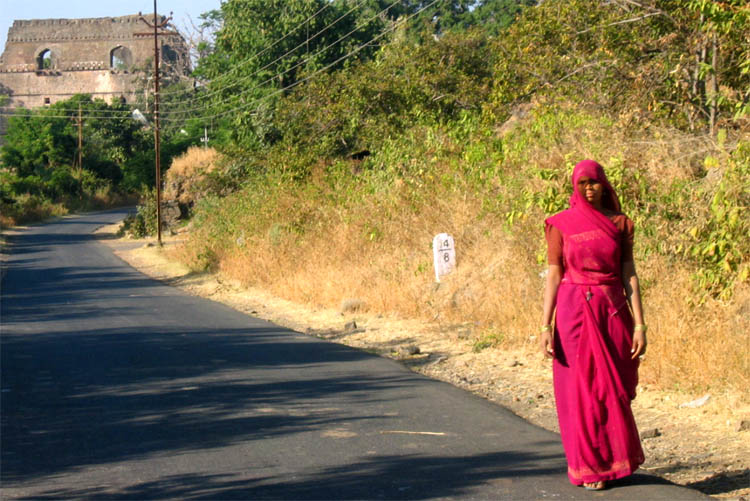
| On the road to Mandu, not Mandalay
|
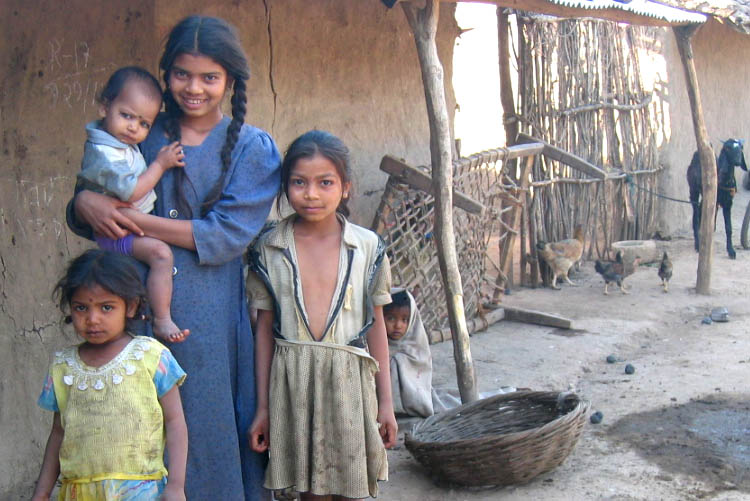
| but in this village I did not stay
|
But before we reached the "back door", we encountered some interesting places we already saw from the road, which we would not have seen if entered through the official entrance. None of the following buildings were listed in our guide book either, except for the Traveler's Lodge and Hotel Rupmati.
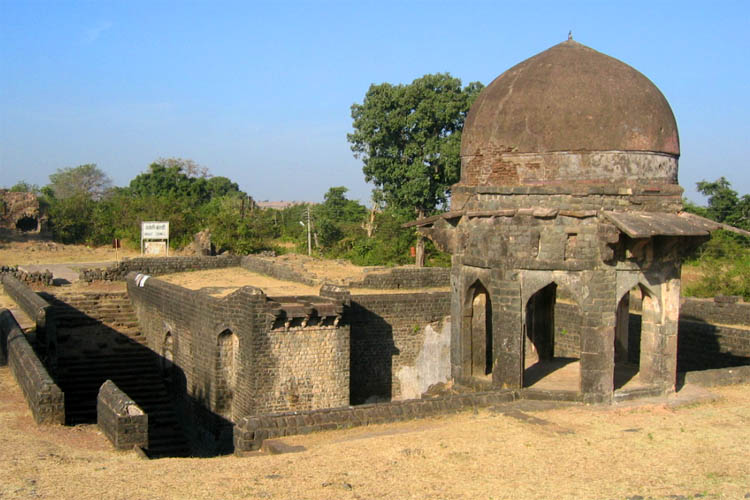
| Not stay here either, I'm not a fool
|
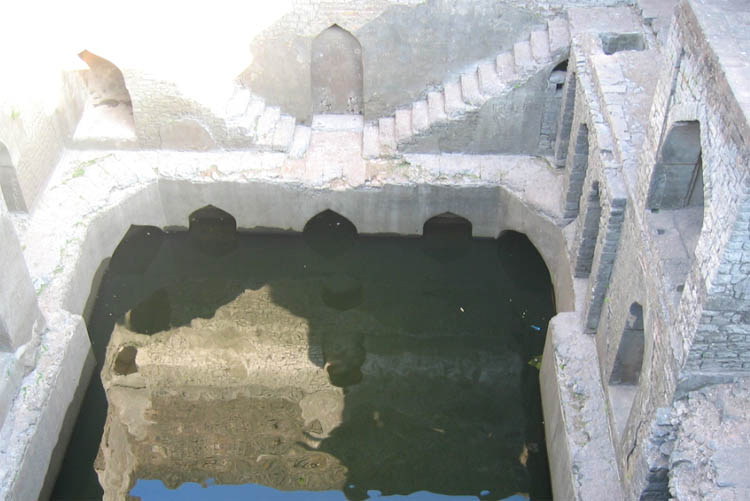
| even if it had a swimming pool
|
Finally we reached a huge gate, the Delhi Gate. We even found out now, that we already had been in the huge fort area stretching over at leat 100 qkm surrounded by walls. After climbing on top of the wall we had a magnificent view.
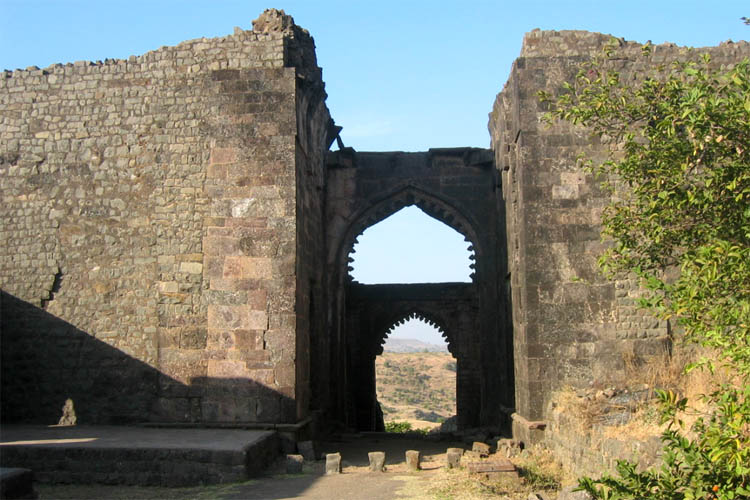
| That's the gate to
|
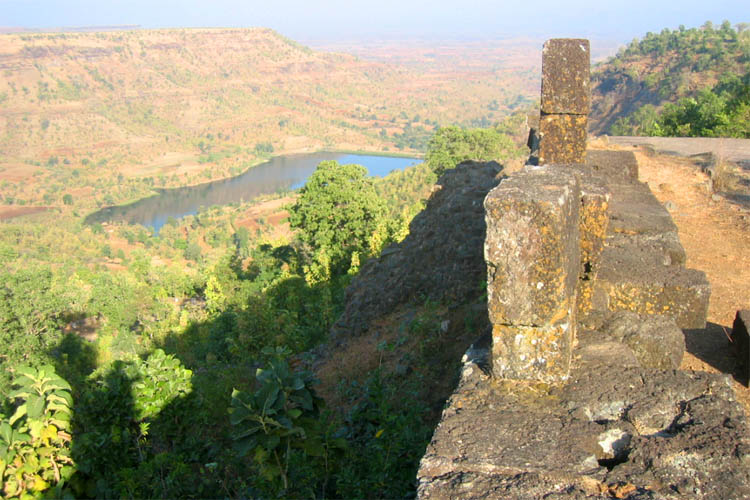
| the Promised Land
|
Finally we reached the inside wall supposedly surrounding the Royal Enclave Group (there are several groups within the huge fort). How to get over? No problem, some kids showed us the spot where we easily could get to the other side. They have earned a backshees.
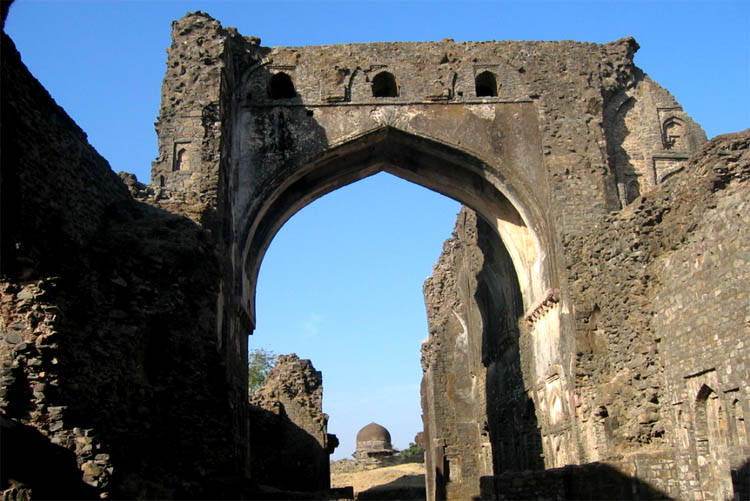
| And this is the gate
|
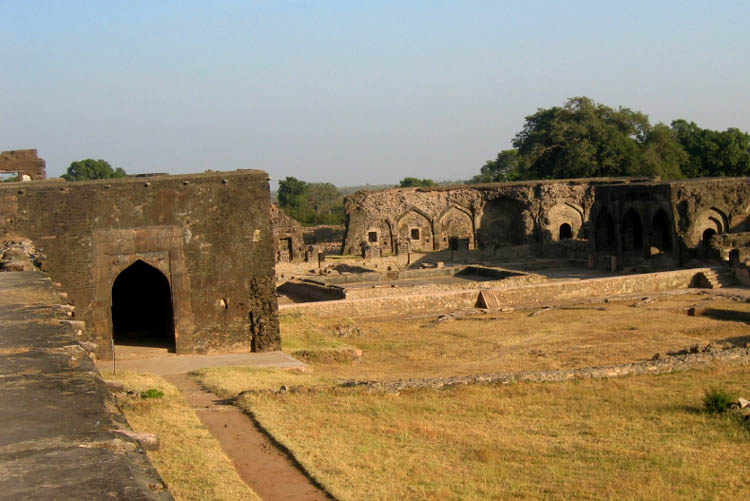
| to maharaja's wonderland?
|
Mandu became a capital in the beginning of the 15th century, but it's splendor only lasted for 150 years until conquered by Akbar the Great (not Allah Akbar) and eventually became a ghost town (or ghost fort) soon after. But let's look at some of the remaining structures. The Hindola Mahal, which looks like a church, is called Swing Palace not because of the swinger parties held there (see Maharaja's life style later), but because the walls seem to swing while looking at the inward slopes.
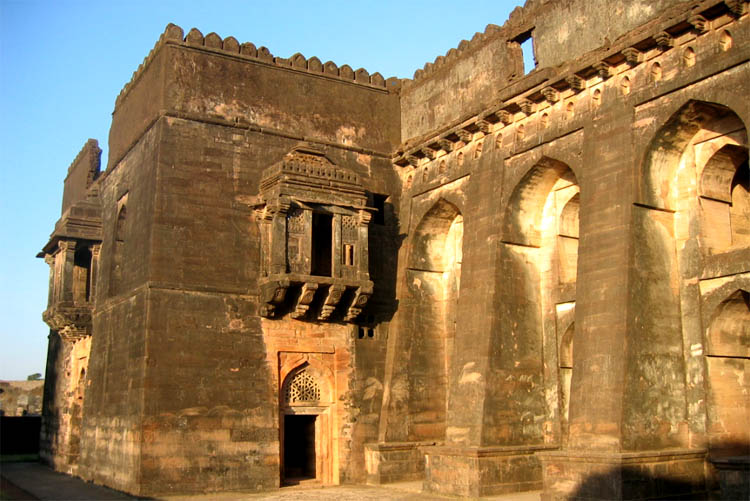
| With fantastic buildings
|
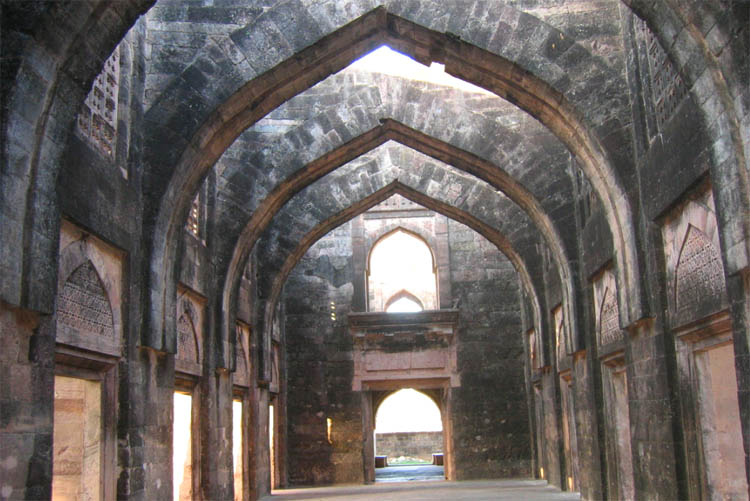
| and a wonderful hall
|
Another building features a tank and a staircase to get down to the subterranean cool wells and bathrooms. The nobles knew how to enjoy life like the roman.
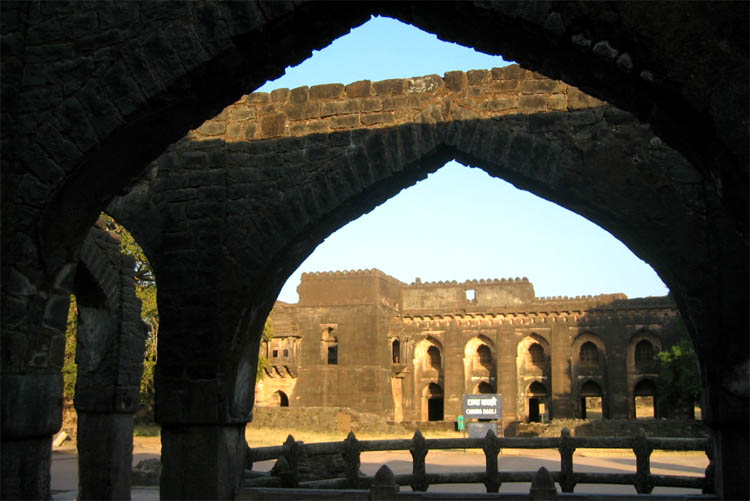
| Must have been one of the maharaja's marbles
|
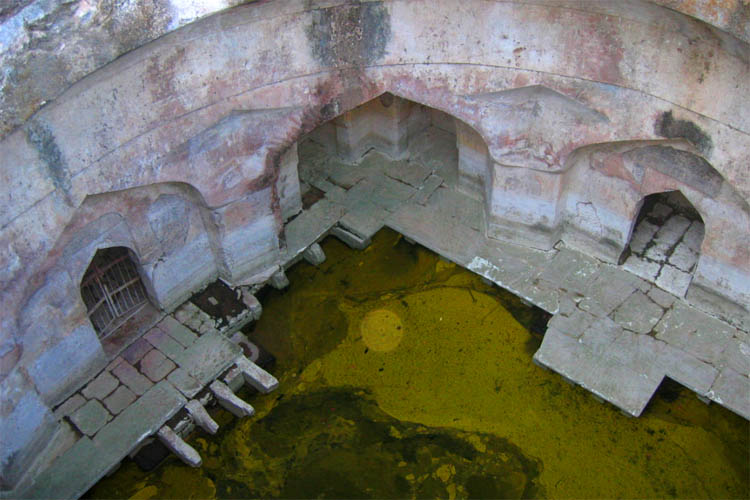
| and a wellness swimming pool filled with green herbals?
|
But the most famous building is the Jahaz Mahal, the Ship Palace, so called because it has a ship like shape 120m long and 15m wide.
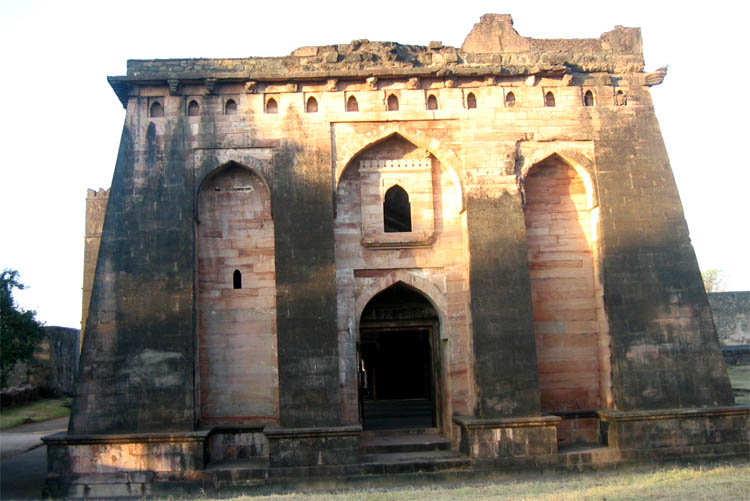
| That seems to be the Grand Reception Hall
|
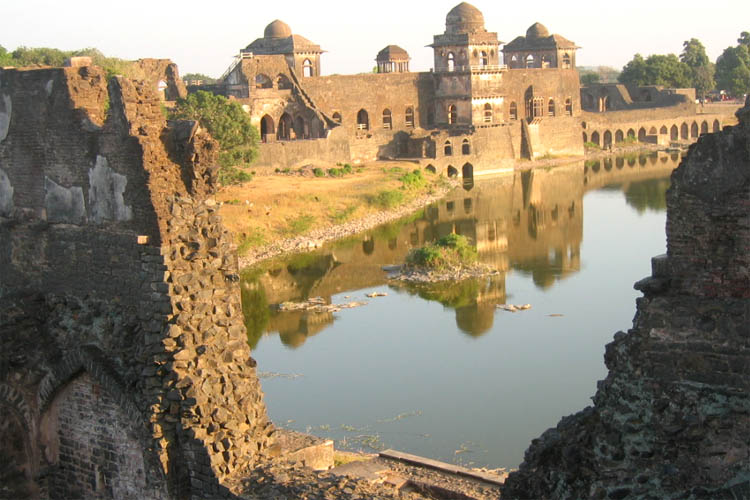
| Here you see the palace through the wall
|
And why it is so famous? Because it was build for the harem of not Salah al-Din (Saladin) but Ghiyas-ud-Din. What do think, how many girls it housed? Supposedly 15,000.
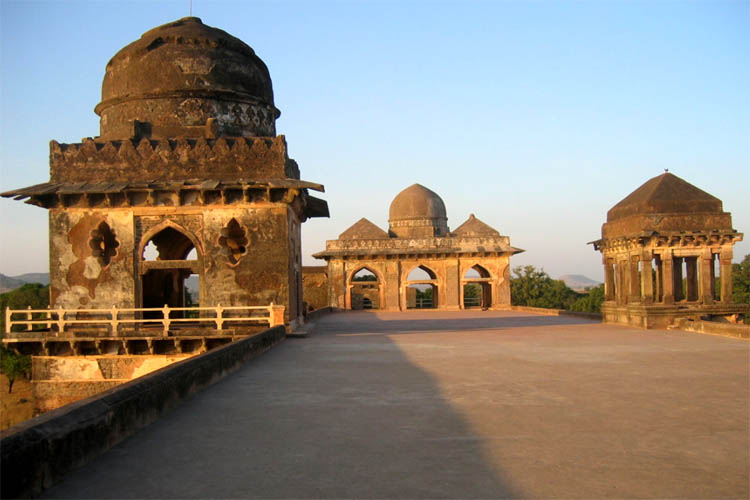
| From this palace here the maharaja did rule
|
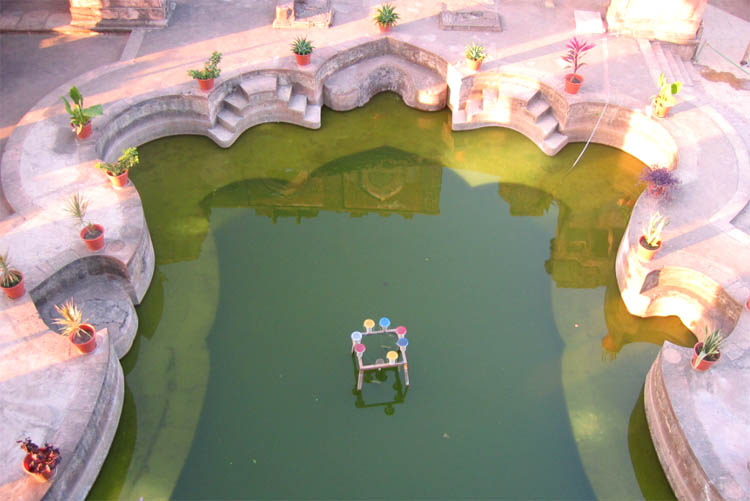
| his 15,000 wives lying around this beautiful pool
|
The maharaja ruled from 1469 for 33 years. Do your math: with how many could he have slept with each day (and night) on the average without having the same girl twice. He could have done it for a longer period, but unfortunately he was poisoned, at an age of 80, by his son. The women also should have had a wonderful life; some might have even be content with just one encounter. Mandu is also called the city of joy, now you know why.
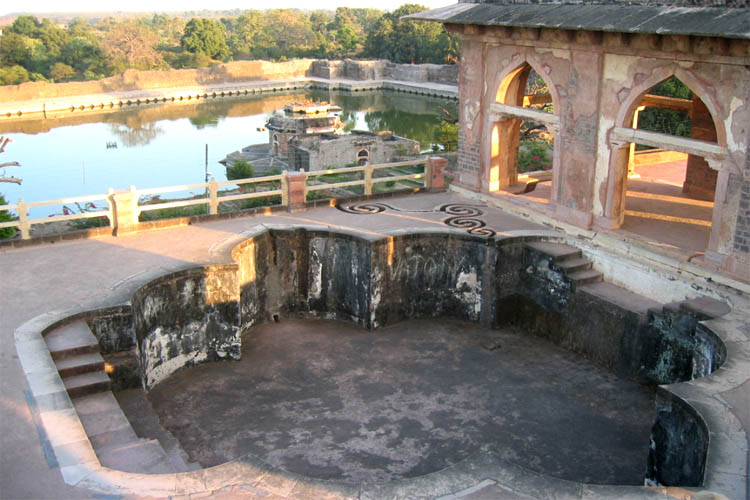
| This swimming pool, though dry, is really fine
|
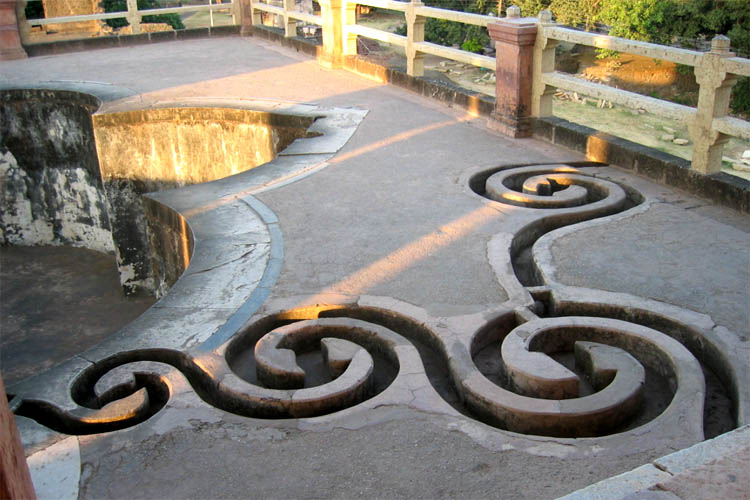
| Architects, look at this beautiful design
|
Soon I had to stop dreaming of swimming in that nice pool and I would have already been satisfied with 100 beautiful girls around. Next day we continued with our sight-seeing tour by hiring bicycles (0.50 Euro for the whole day) and thus bicycled to the next group of palaces, called the Rewa Kund Group, which was 4km south of the Mandu village.
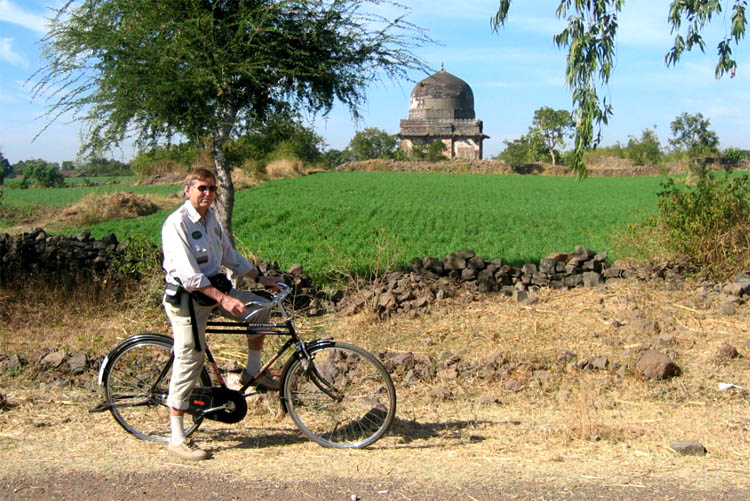
| Bicycling to many other places I have not been
|
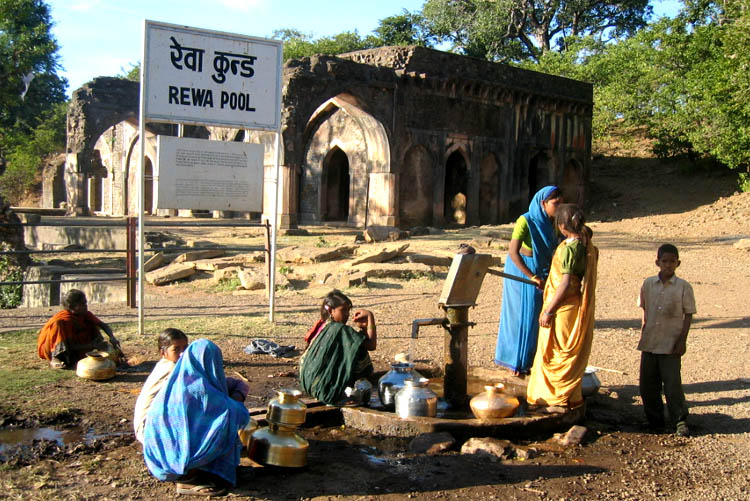
| Getting to a more different pool than what I have seen
|
Then another 500m up the hill and at the final edge of the fort I was rewarded with the sight of the Rupmati's Pavilion and a wonderful view down to the countryside below. Manfred somehow wasn't that much interested walking up the hill, so I had the palace all by myself. While strolling around I was thinking of Rupmati. She was a beautiful Hindu singer who became the wife of Baz Bahadur, the last independent ruler of Mandu, who build that palace for her.
When Akbar heard of the beauty of Rumati, he conquered Mandu and wanted to conquer her, too. But before he was able to, she committed suicide by poisening herself rather than falling in Akbar's hand.
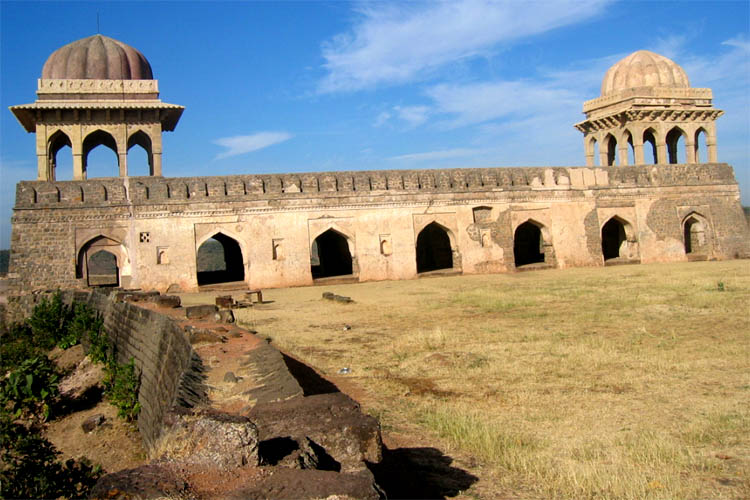
| To a palace up the hill I had to push my bike
|
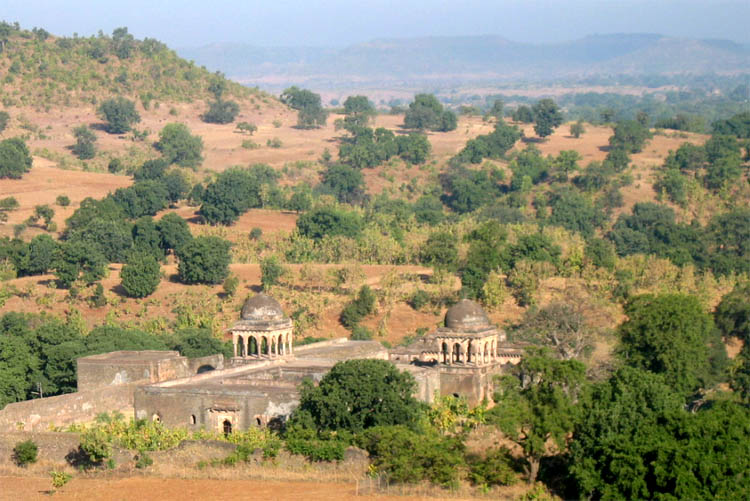
| to be rewarded with such a wonderful sight
|
On the way down I took a look at the Palace of Baz Bahadur. That coward fled (in the year 1561) before the advancing army of Akbar, leaving Rupmati to her fate.
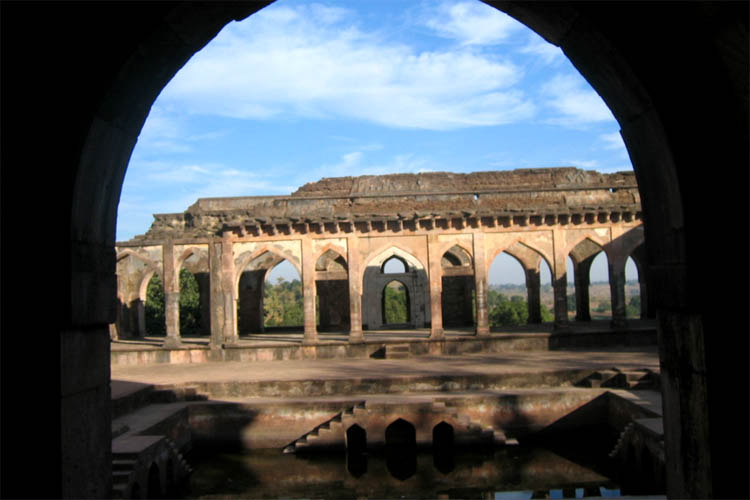
| Another pool proves the maharaja's spoil
|
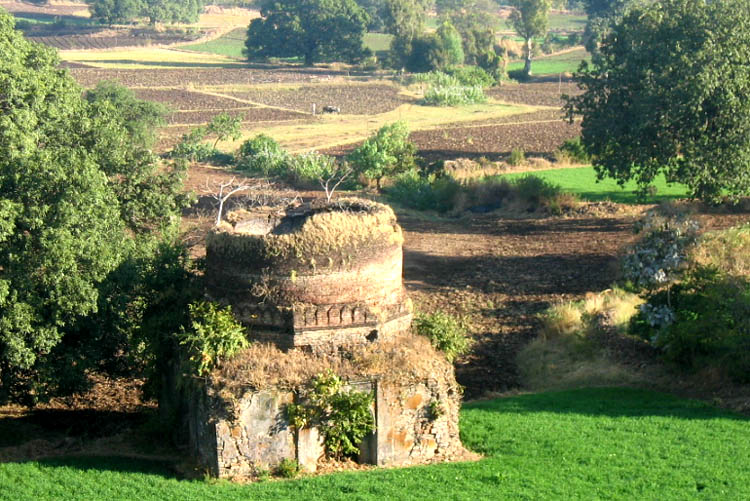
| funded by the produce of the fertile soil
|
The Mandu village itself only consists of a main street, a market place and some restaurants amidst an old mosque, a Jain temple and two tombs but still worth taking a look at them. It also was an evening meeting place for the few travelers (at the time we were there).
Back to Indore
Next day, 8th of December, we also fled Mandu (couldn't stand the stinking squat toilet anymore). After three and a half hours by a direct bus this time we arrived again in Indore, where we stayed at the
Hotel Neelam
33/2, Patel Bridge Corner
Tel: 0731- 2466001
|
The hotel was ok and the room rate was only 198 Rupees (3.50 Euro).
First thing now was to get train tickets for our next destination: Mumbay (former Bombay). And that was not so easy as said. After asking around we finally found the reservation station, which was not in the railway station but somewhere in town, but not far from the real one. There we were told that all seats for the next 2 weeks were sold out.
If I would not have asked for VIP tickets (I read something about a special contingent), we really would have been stuck, not necessarily indoor but in Indore (a bus would have been another option, though). The reservation lady recommended to go to the station master in the railway station, what we did.
He was a very nice guy and after we chatted for some time - answered all his questions like we were being interrogated - until he finally found us elegible for two VIP Tickets to Mumbay with the night train on December the 9th. The fare for the two sleepers was only 571 Rupees (10 Euro).
So we had almost the next day for sightseeing in Indore. Very interesting was the Jain Temple amidst the colorful bazaar area.
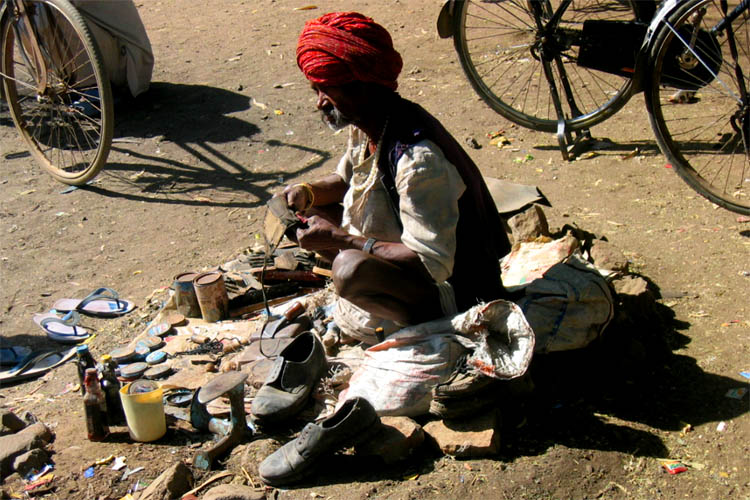
| Need a shoe repair after walking miles
|
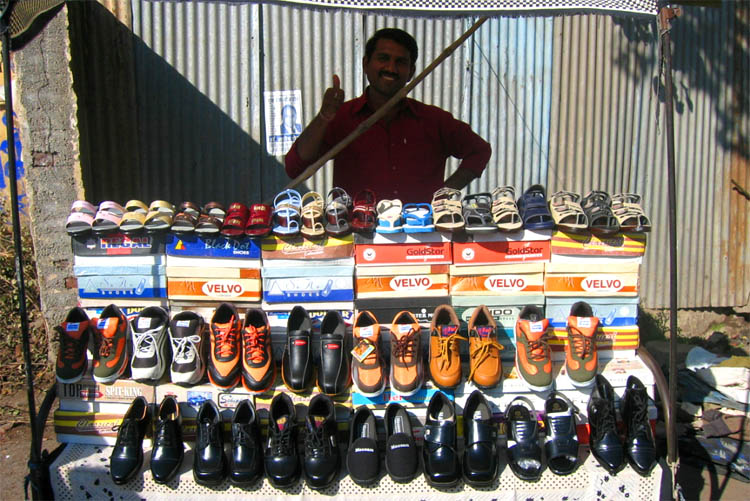
| or buy a new pair made of real cow hides
|
On the train we met a nice and very talkative German nun who lived in Mumbay for already 40 years working as a nurse in a children's hospital. She told us a lot about India and she knew how to travel on a train: Chaining and locking her stainless steel suitcase to the iron bars under her seat while she was sleeping. We had to share our small sleeping space with our backpacks while trying not to fall out of bed. Stealing (not steeling) on trains is a common pastime.
Pune
Arriving in the morning in Mumbay on the 10th of December we boarded a "Pritam-Vinay Tours and Travel" bus to Pune (former Poona) for 360 rupees (6,30 Euro) for the two of us.
The only reason for us to stay in Pune was, of course, the Osho Commune (or former Baghwan Ashram). Still being very attractive for many westerners. So it was hard to get a room for the night in Koregaon Park area, close to Osho, because many Sanyassins sleep outside the Osho Commune compound (though they also have a hotel inside, but more expensive).
We would have preferred
Happy Home but it was full, so the taxi driver was driving from one hotel to the other until we did get a room for Manfred in a hotel close to the North Main Road and I was put into a student's room in a dependency of Manfred's hotel in a side street further up the road but close to the Prem Restaurant (very good; full meal with drinks for 329 Rupees, i.e. 6 Euro) and still within walking distance to the Osho Meditation Resort.
Another hotel I would have liked to stay, was the
Hotel Sunderban
19, Koregaon Park
Pune
Tel: 26124949
|
next to Osho Commune. Room rates are from 400 to 3000 Rupees (7 to 50 Euro), from Economy to Osho Suite and Studio Room. Look up their website
www.tghotels.com,
if you want to know more.
Yes, the Osho Meditation Resort really is a very nice resort to stay there a couple of days, even if you do not meditate or join all the activities offered. And that's what I did: became a sanyassin for three days, after going through some tests (mainly a negative AIDS result was the entry ticket). Manfred was not convinced and attended only an introductory tour for three hours and subsequently left for Goa already next day.
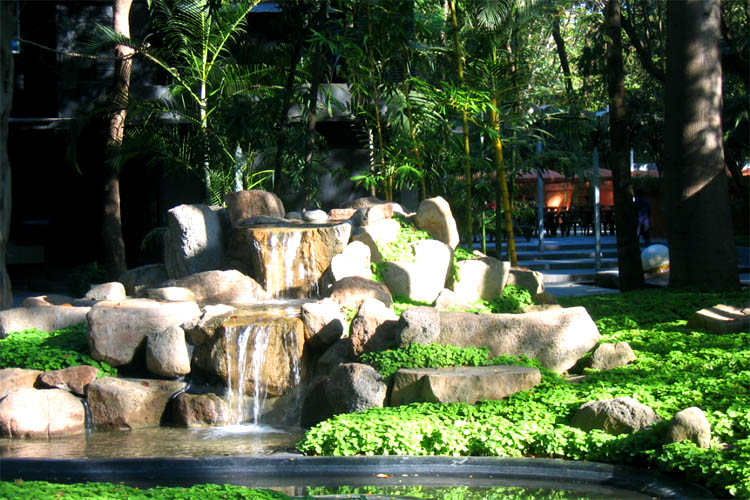
| The park around the ashram compound
|
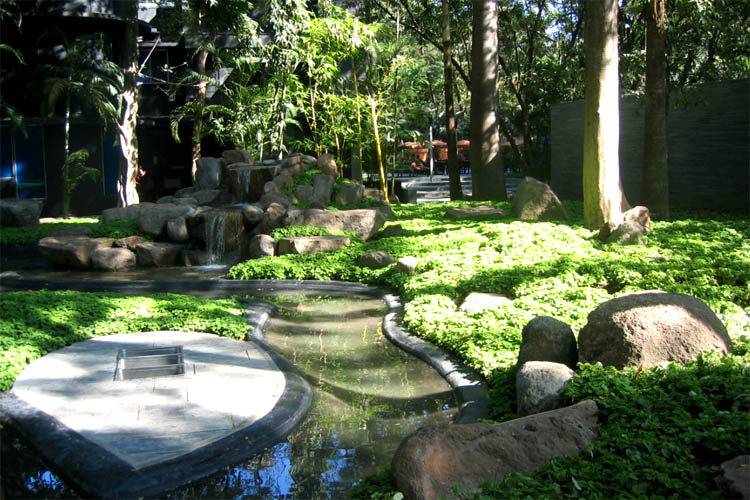
| looks very quiet with no sound
|
And I really enjoyed it. Also, it was not expensive at all (night stay not included though). Even the mandatory outfit, one white and one maroon one (including socks same color) could be bought with little money. I could keep telling more about this resort, like it is the most sanitary place in one of the most dirty countries in the world. Look up the internet site for more and last updated information.
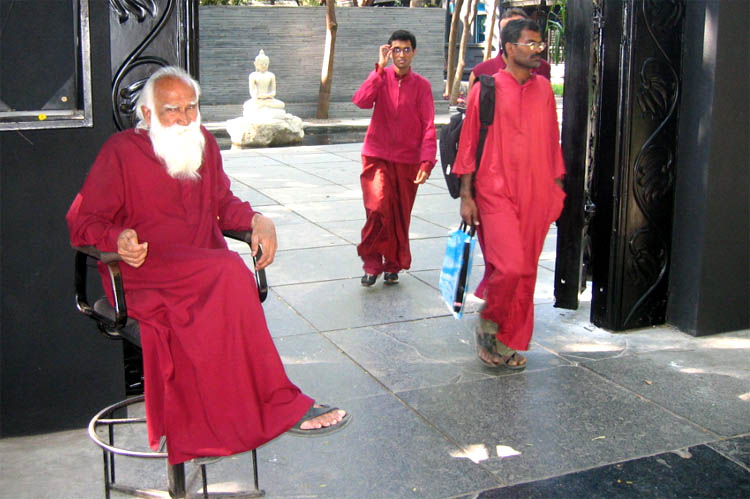
| I decided to join the sanyassins
|
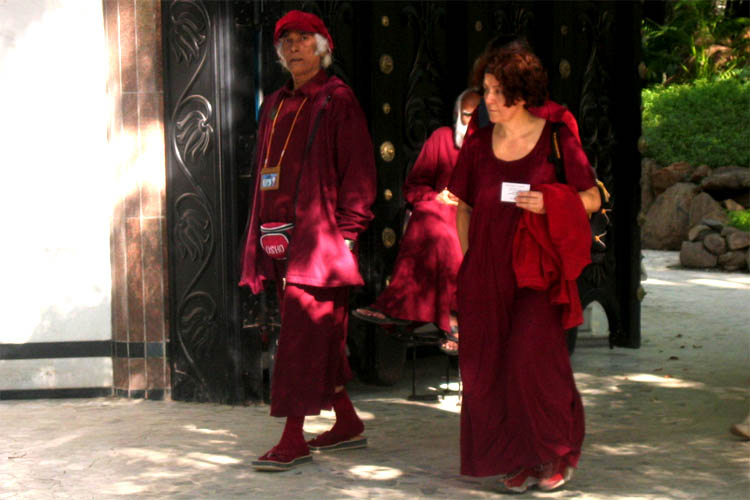
| like so many other Caucasians
|
Not all the travelers in Pune join the Sanyassins but just enjoy the traveler's scene around, at the German bakery, for example. It is the best place to chat, relax and enjoy coffee and some healthy food.
Goa
On December 13th I took the night bus to Goa. The sleeper for 500 rupees (9 Euro) was very comfortable but it did get very cold during the night. I should have bought a blanket for my thin sleeping bag. Was then happy to arrive in the warm morning sun at the bus station in Goa, where I had to hop on another bus going to Colva Beach. Manfred was already waiting at the Colva Circle to pick me up and after a 3 minutes walk on the beach to the left we reached our
'C' Roque Resort
Sernabatim, Colva Beach
Tel:2532170
Email:croque@goatelecom.com
|
The single room with attached bathroom was 500 rupees per day (8.70 Euro). It was Manfred's favorite place to stay (he did so before). The restaurant was right in front of the beach and always the place where we had our sundowner (bought a bottle of Gin in town and ordered Sprite in the restaurant). There were many restaurants left and right of the Colva Circle to choose from.
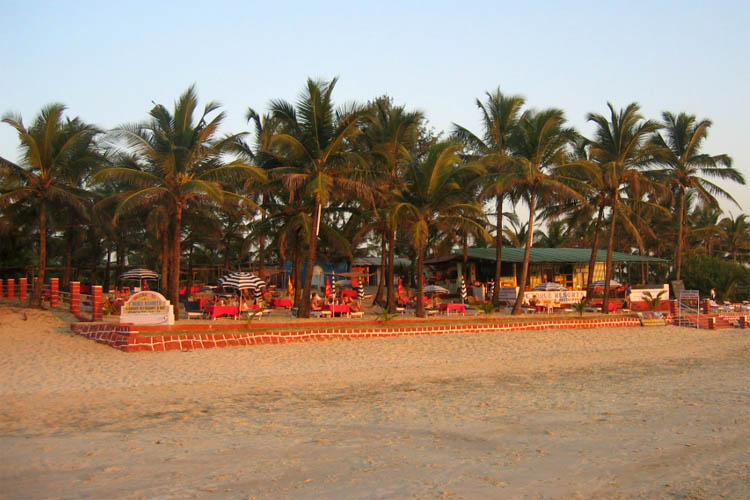
| Goa, and our resort we finally reach
|
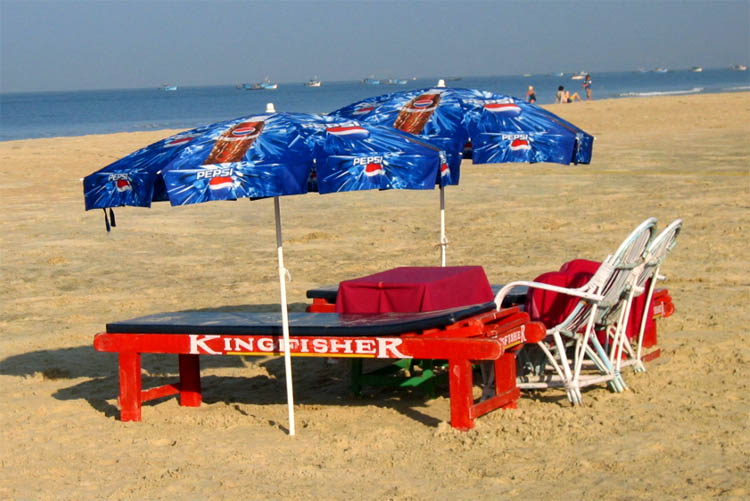
| relaxing now all day on the beach
|
The Colva Beach was the best beach all of Goa, especially for old people like us looking for a relaxing stay after our strenuous trip through almost half of India. You can also watch Indians at work, either fishermen coming back with their fleet's catch or show business people performing as acrobats on the beach.
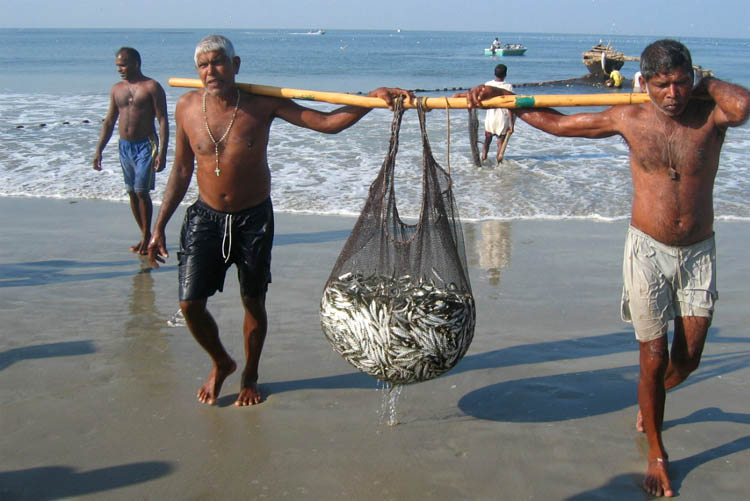
| Some locals work hard in a fisher's fleet
|
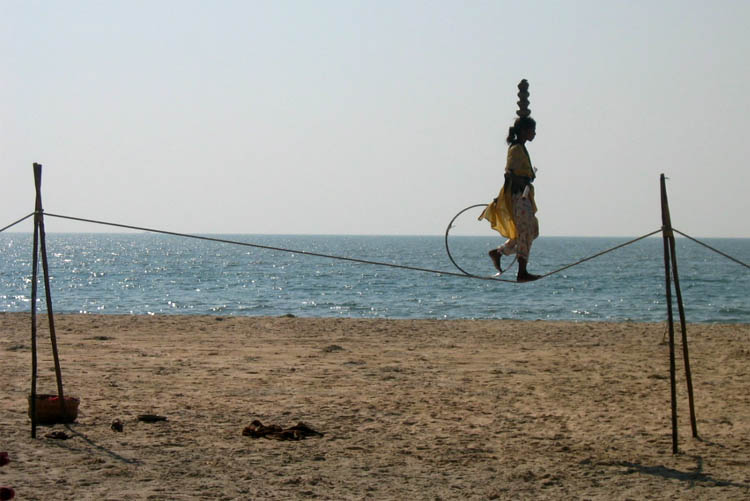
| some even as an acrobat, to make both ends meet
|
Not many tourists were around, so we had the beach almost to ourselves. Only in the evening the locals came for a last swim in the sea (women fully dressed) or a sunset walk .
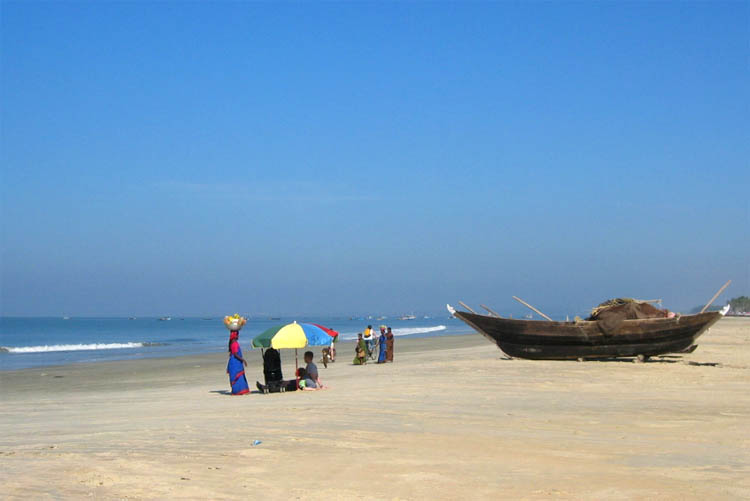
| During the day the beach is deserted
|
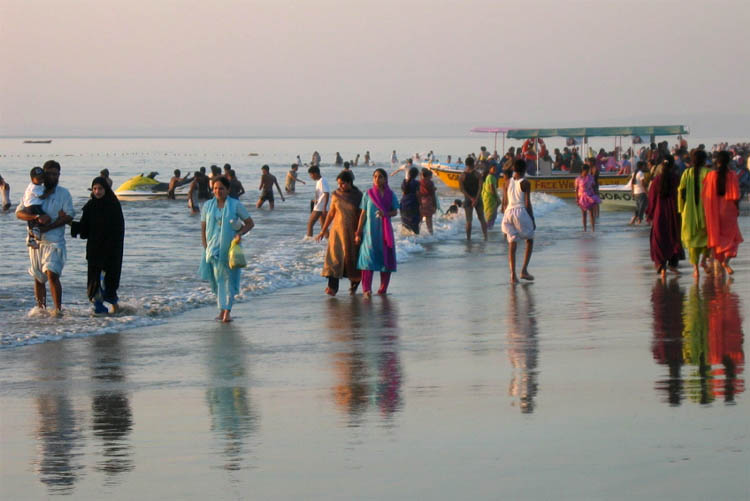
| In the evening the beach is converted
|
The Colva Beach is too long for walking all the way, even to one end (12km alone to the south). But just right for a bike. Even the sand is not too soft to get stuck.
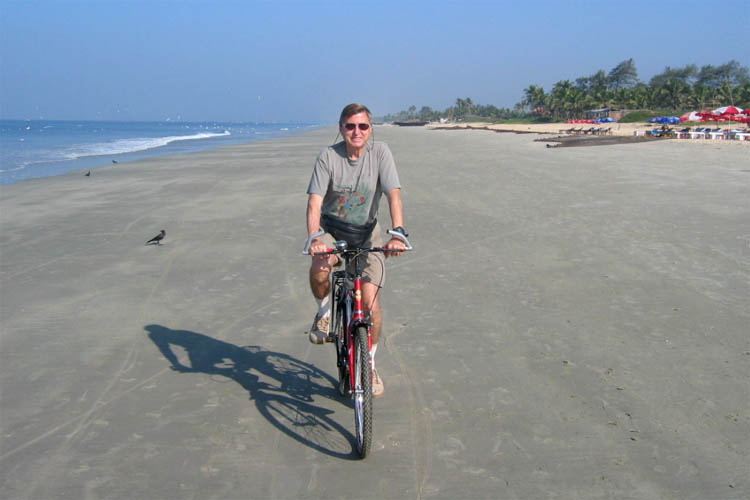
| Next day is another day for bicycling in order to reach
|
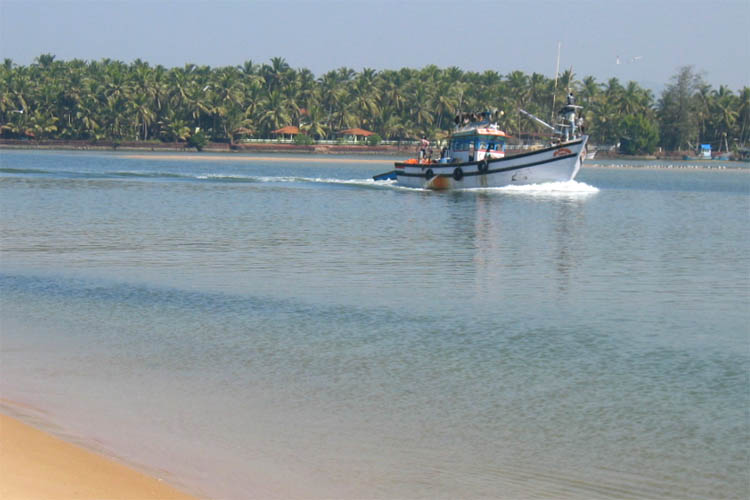
| twelve km down south the end of the beach
|
All of a sudden our nostrils were filled with a stench and we followed the smell and discovered a whole field with piles of small crabs and fish being dried. Women were busy turning them around so that they can also get dry from all sides and not get even foul.
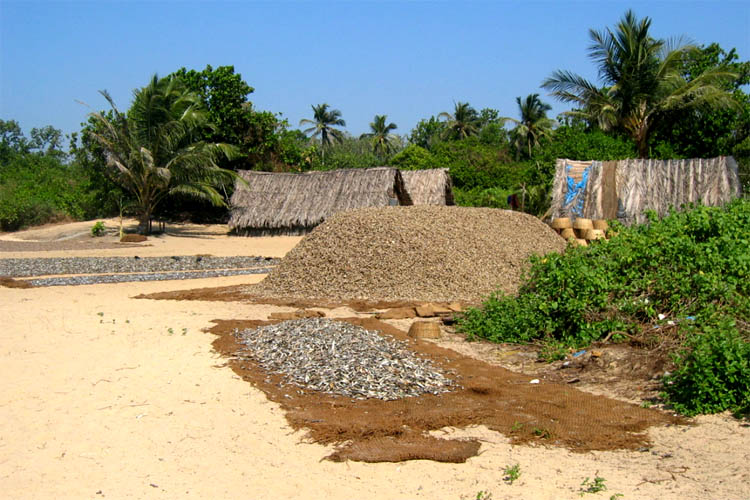
| Piles of drying crabs and fish
|
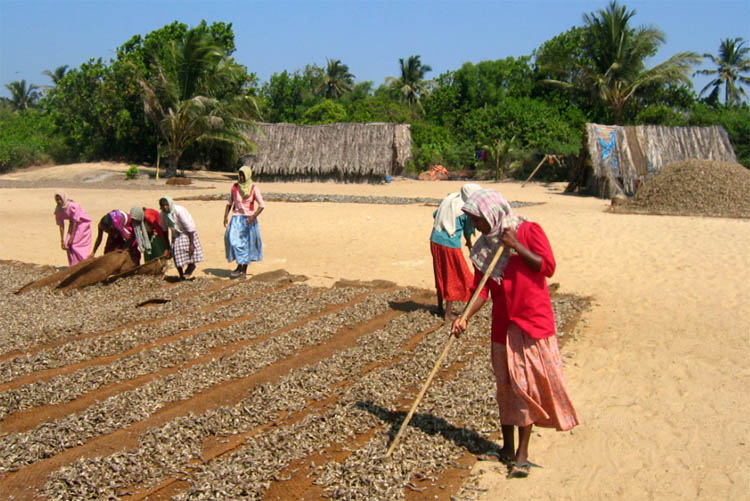
| It's not my treat for a dish
|
There was not much else to do. Fortunately there were no jet skis making a lot of noise, but only a motor boat pulling a parasail once in a while. The most quiet place was in the back yard of our resort, just right for a little meditation in my Osho outfit (had to also utilize it, ok).
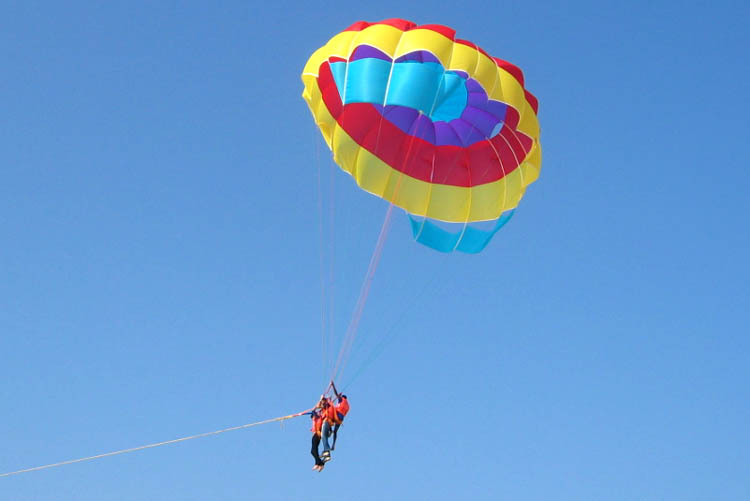
| What to do: either flying in the firmament
|
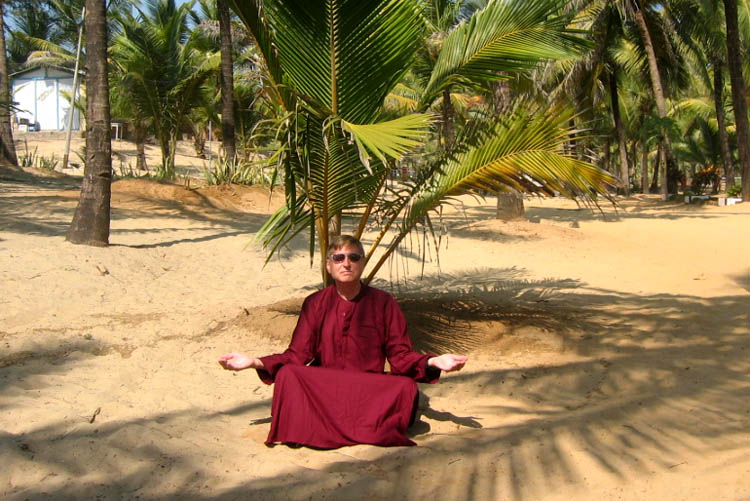
| or meditating for enlighten-ment
|
However, one day I had the urge to leave the tranquility of Colva. Manfred didn't, so I threw myself into the most colorful and busy market in Goa, the old hippie market in Ajunja, which also happened to take place next day on Wednesday. Taking the local busses to get there and return the same day would have been cumbersome, so I joined a daily tour.
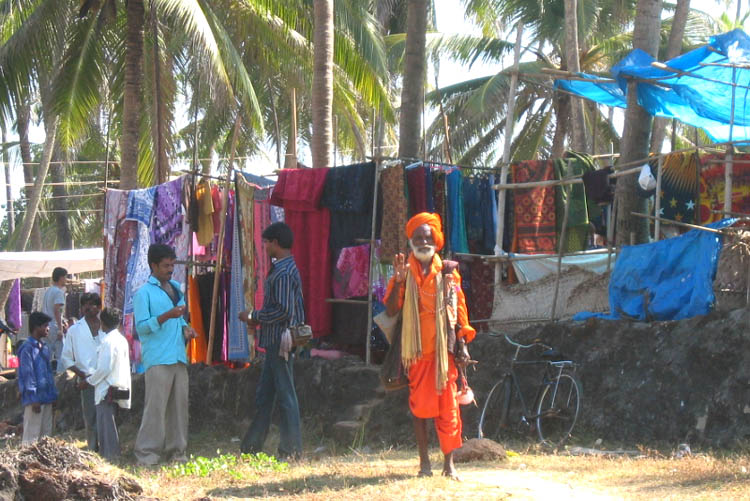
| Getting the absolution on the Anjunja beach
|
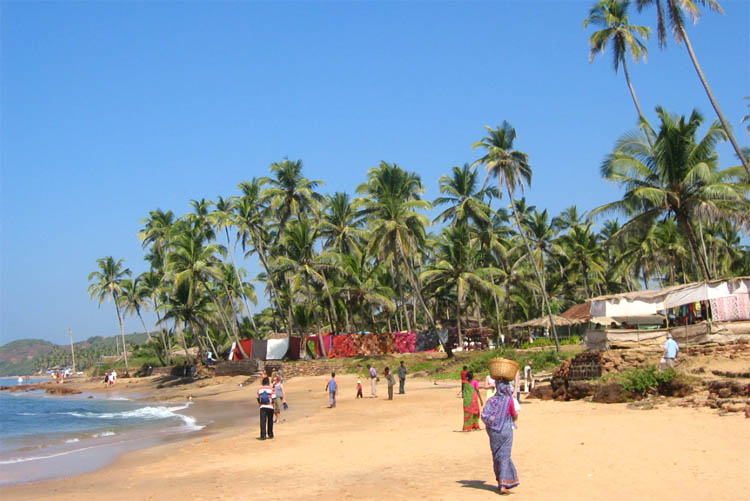
| this stretch of beach still looks tranquil
|
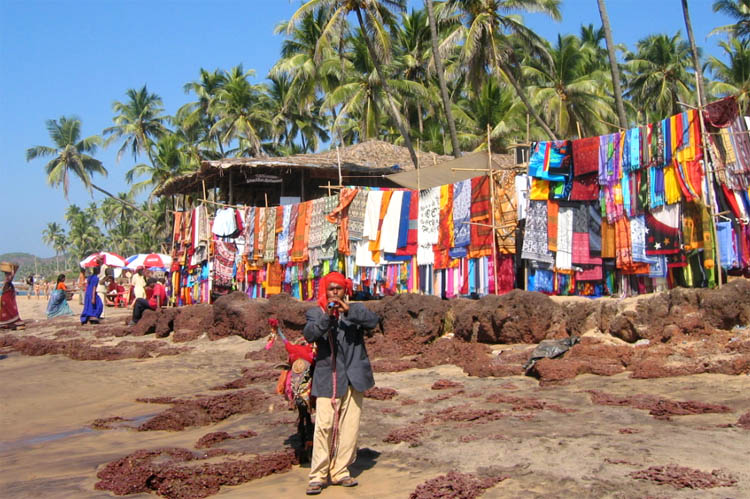
| At first you hear a flute with a soft sound
|
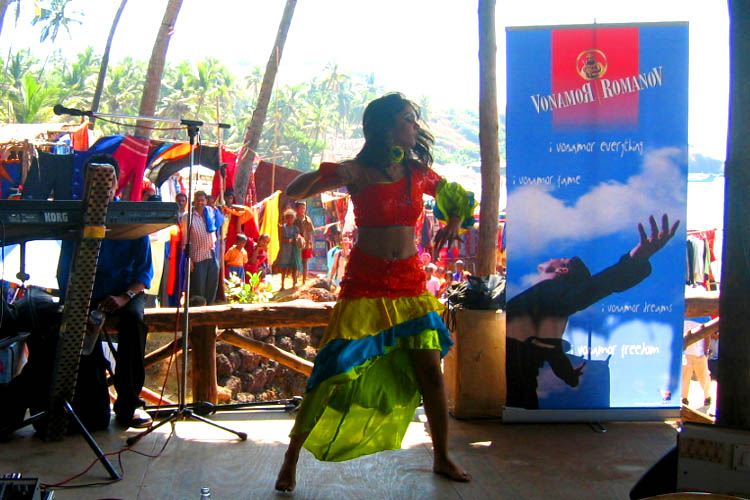
| but then a ghetto blaster gets aloud around
|
During the hippie area this was the famous Ajunja beach to stay and smoke the cheap joints bought in Katmandu (by travelling back and forth for new supply). The little money they needed was easily earned with handicrafts sold on this market. So it was originally founded and populated by the hippies. They almost seemed to be gone and the Indians have taken over.
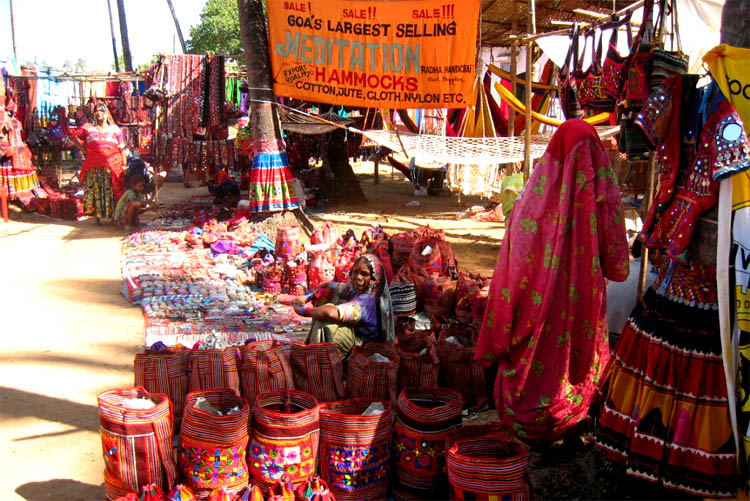
| Where have all the old hippies gone
|
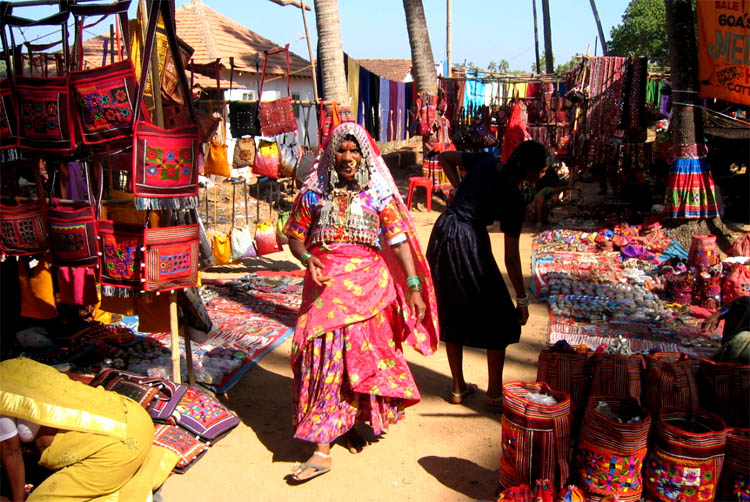
| and where did all the gypsies come from
|
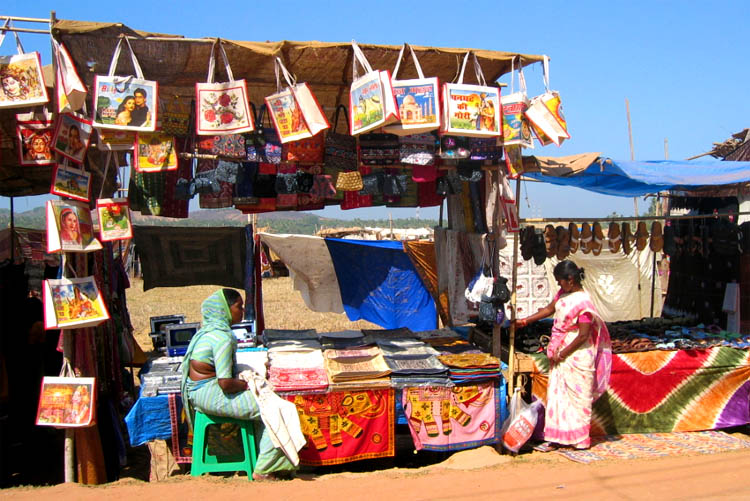
| Indians have almost occupied all places
|
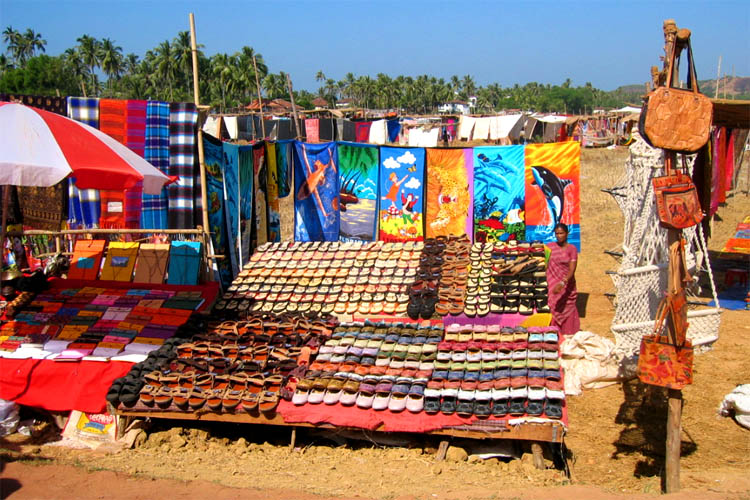
| selling now only "Made in China" wares
|
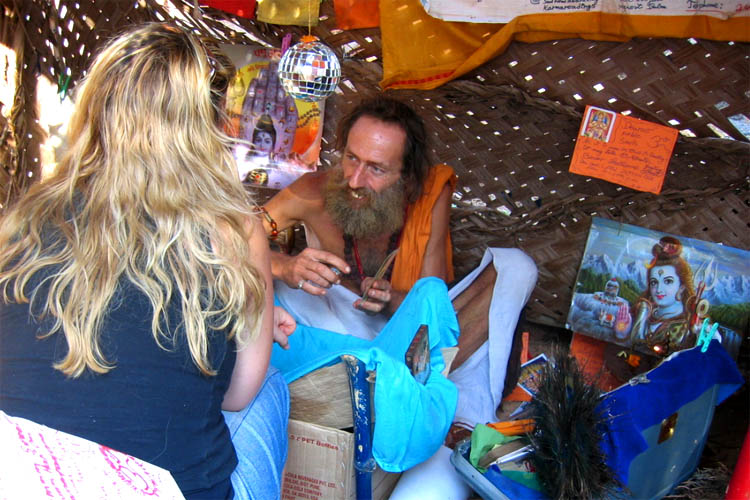
| One of the few last hippies is holding the fort
|
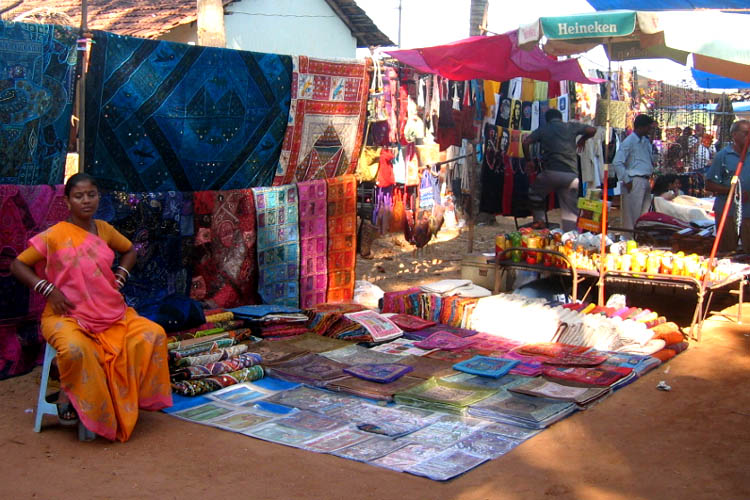
| to get his place, everything the Indian lady will do for
|
Delhi
On December 21st we flew from Goa back to Delhi via Mumbay with Indian Airlines. We had already reserved the flights and the tickets bought in Varanasi for 250 USD each.
This time we booked into another hotel, also close to the New Delhi railway station, which was the
Hotel Pallvi
8572 Arakashan Road
Pahar Ganji, New Delhi
Tel:23530363
Email:chandhotels@yahoo.com
Website:www.budgethotelsindelhi.com
|
The single room with aircon was 795 rupees (14 Euro) and ok so far.
We stayed for two nights in that hotel and had thus two days in Delhi for sight-seeing. It is better to have some contingency at the end of the trip to be on the safe side not to miss the flight back to Germany.
Manfred knew already some interesting places from his previous stay in Delhi, so he played the guide somehow.
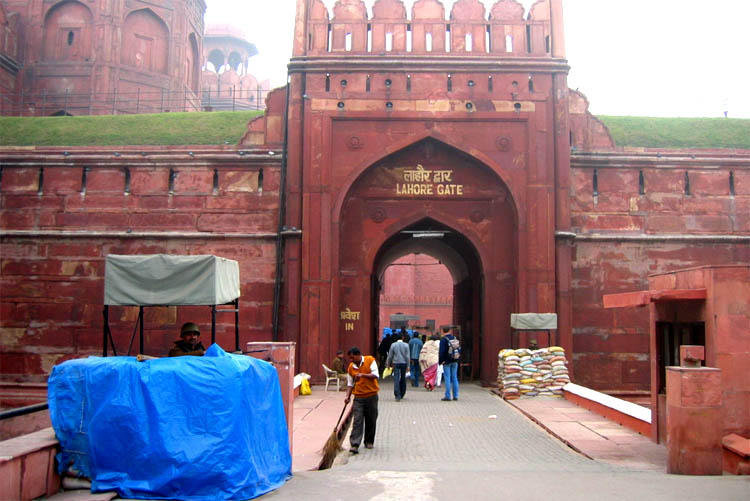
| First to pay a visit to the Red Fort
|
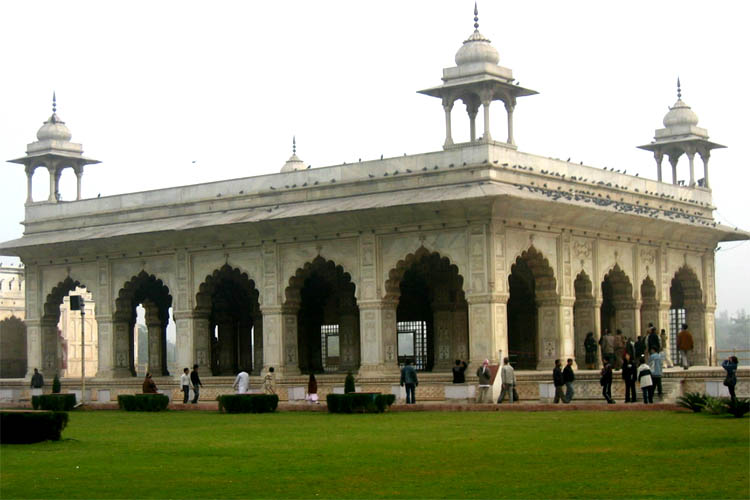
| very well guarded (and the jewels)?
|
The old Delhi Fort was guarded like they feared to be conquered. Soldiers were all over and ready to use their guns behind their pile of sand sacks.
The largest Mosque in Delhi also looked like a fortress. Maybe it had to be in the old days not to be overrun but now it looked falling apart by itself in some places.
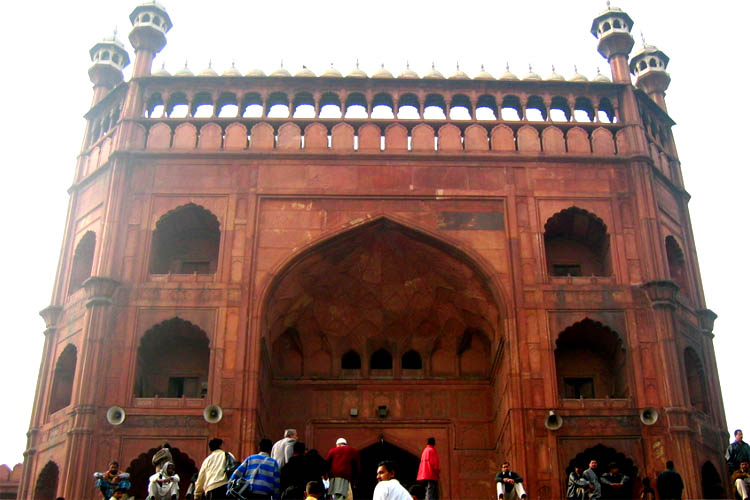
| The fortress Mosque with watchtowers as minarets
|
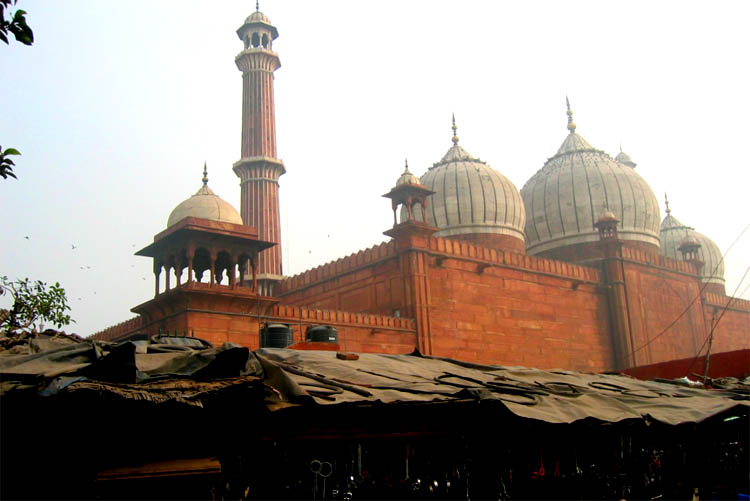
| surrounded by walls all over
|
The temples of Bahai and Krishna were looking much better. Ok, they were newer and ... a lot of money have been collected from followers all over the world to build them.
If you want to know more about this temple of Baha i Faith then just click on
www.bahaindia.org.
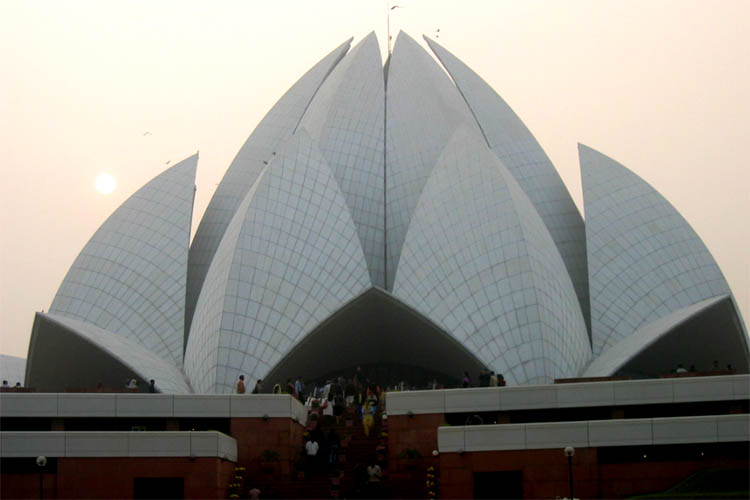
| The Temple of Bahai in fading sunshine
|
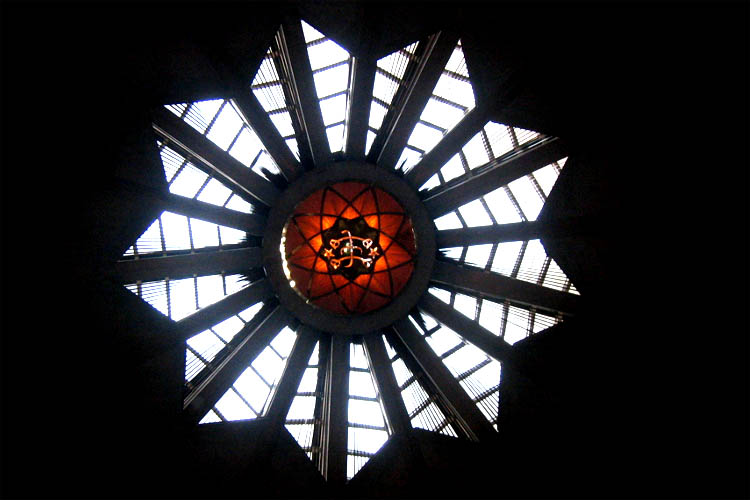
| the star inside is a beautiful design
|
Manfred knew that the best a cheapest restaurant was located in the Krishna temple. We came just right for lunch.
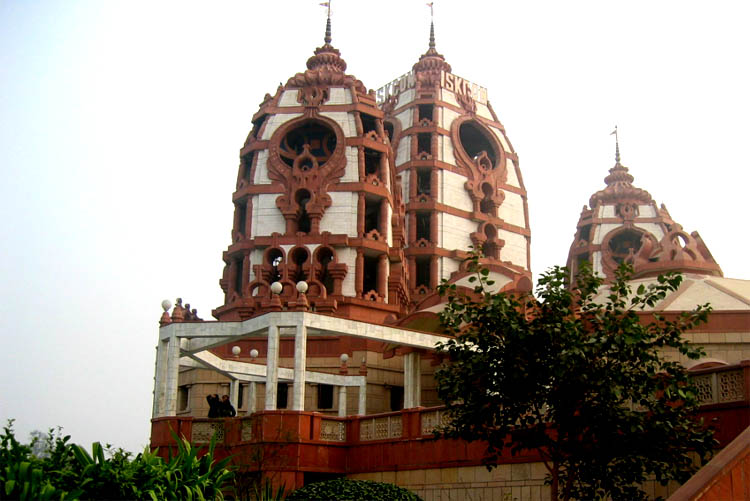
| This is a Krishna temple with a very good cuisine
|
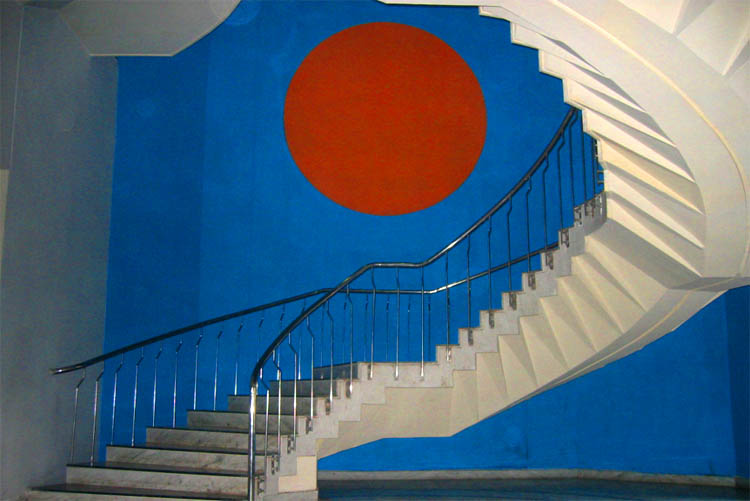
| Inside the most modern staircase I have seen
|
On December 23rd we finally flew back to Frankfurt with Lufthansa and further on again with the Lufthansa train to Cologne.
Ok, that was our trip to India. Actually my fourth one (see my list). India is always an adventure and a new experience, whether a good one (mostly) or a bad one (like anywhere).
If you want to know more about the places we have visited, then just look up any of the many guidebooks or in the internet.
| 






































































































